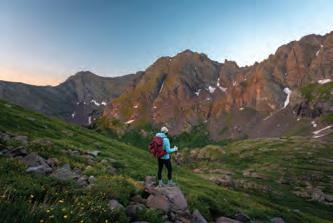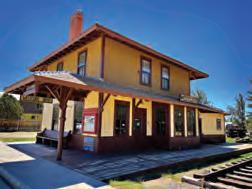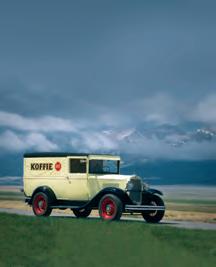MAY/JUNE 2025


MAY/JUNE 2025

A snapshot of Colorado’s biodiversity in one acre.
OURAY’S IRON PATH
The hardest via ferrata in North America
Recipes
Hearty salads fuel summertime adventures
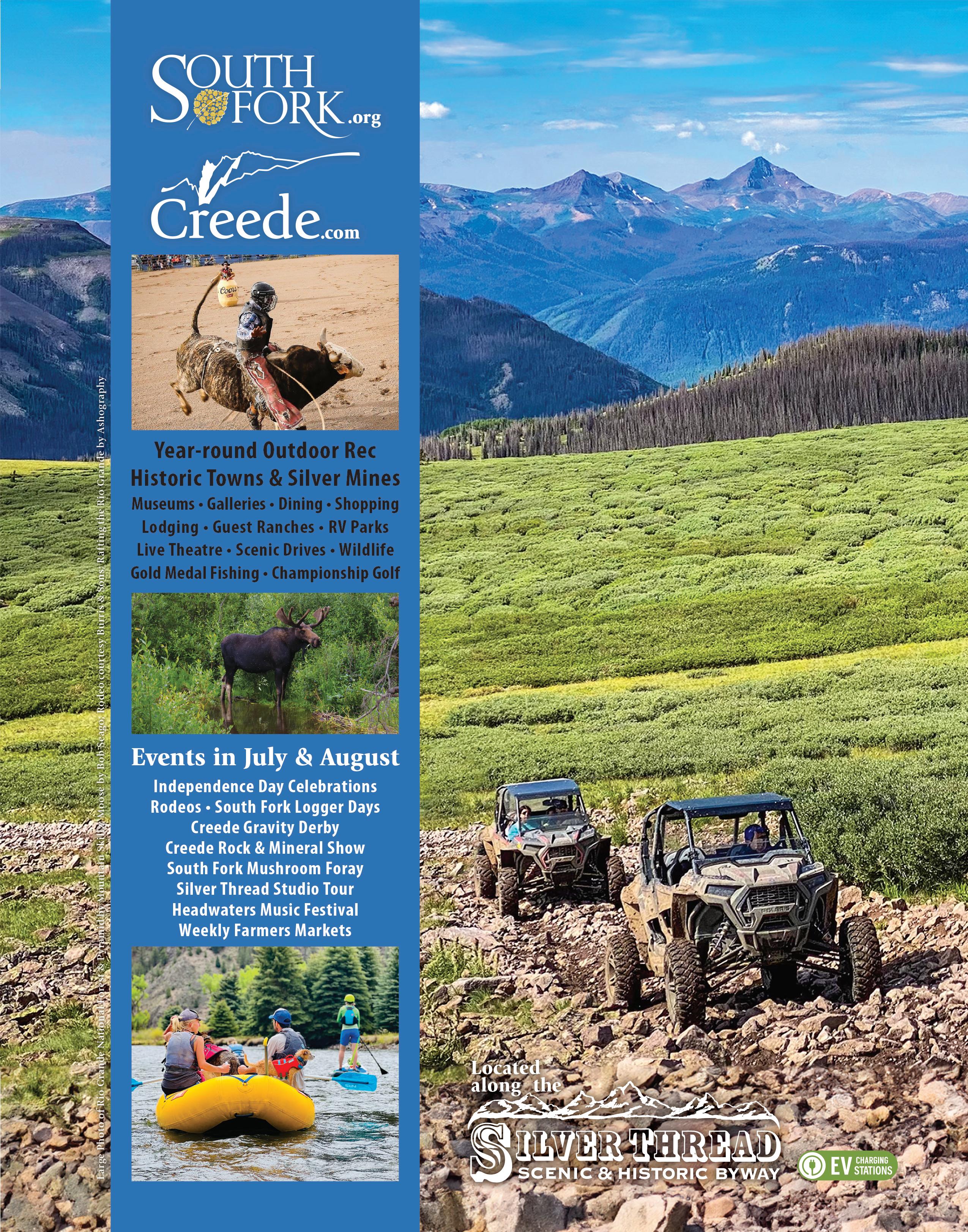

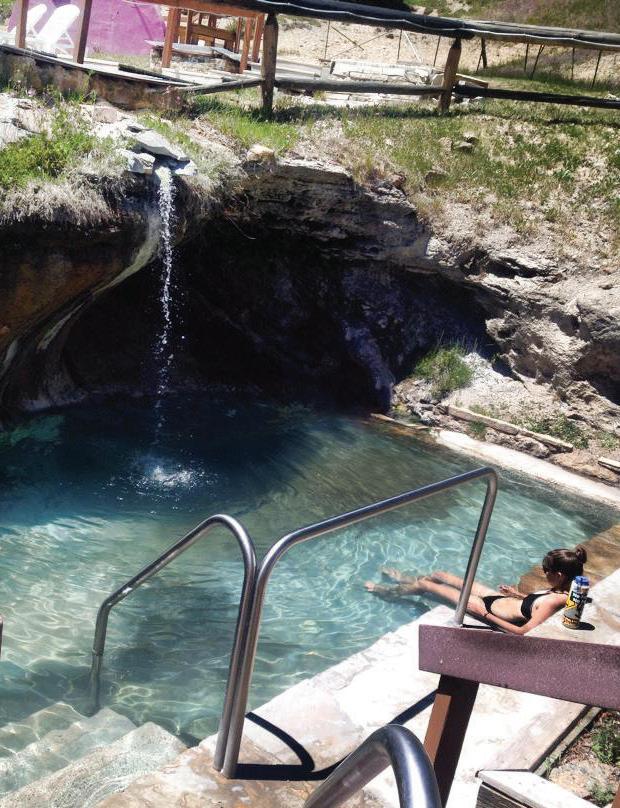

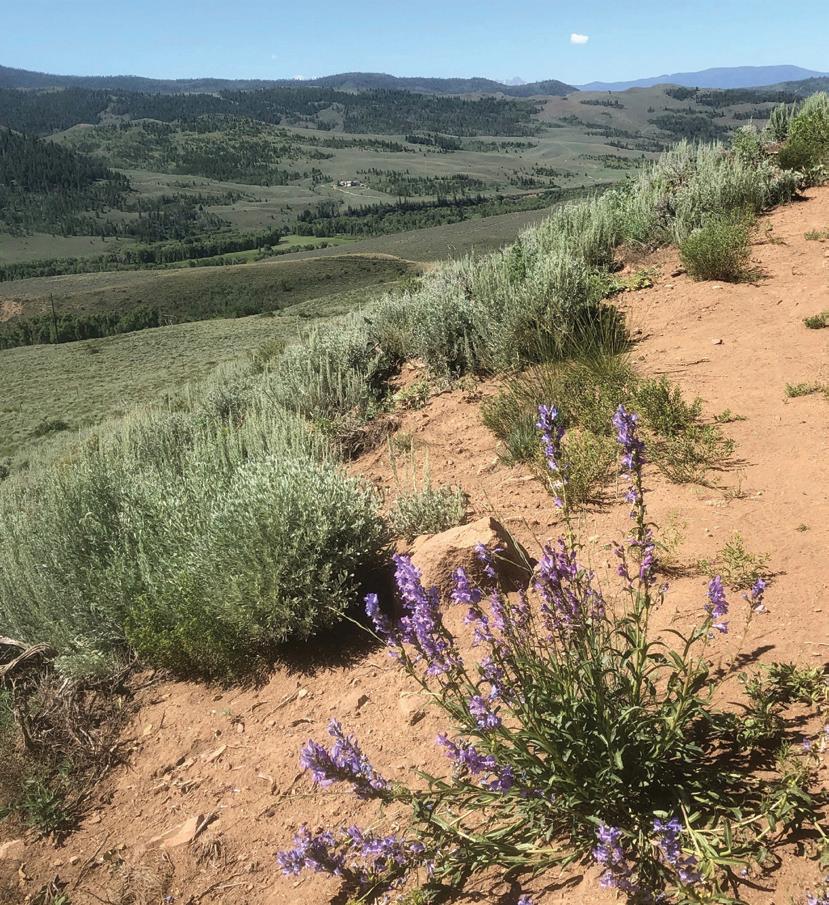

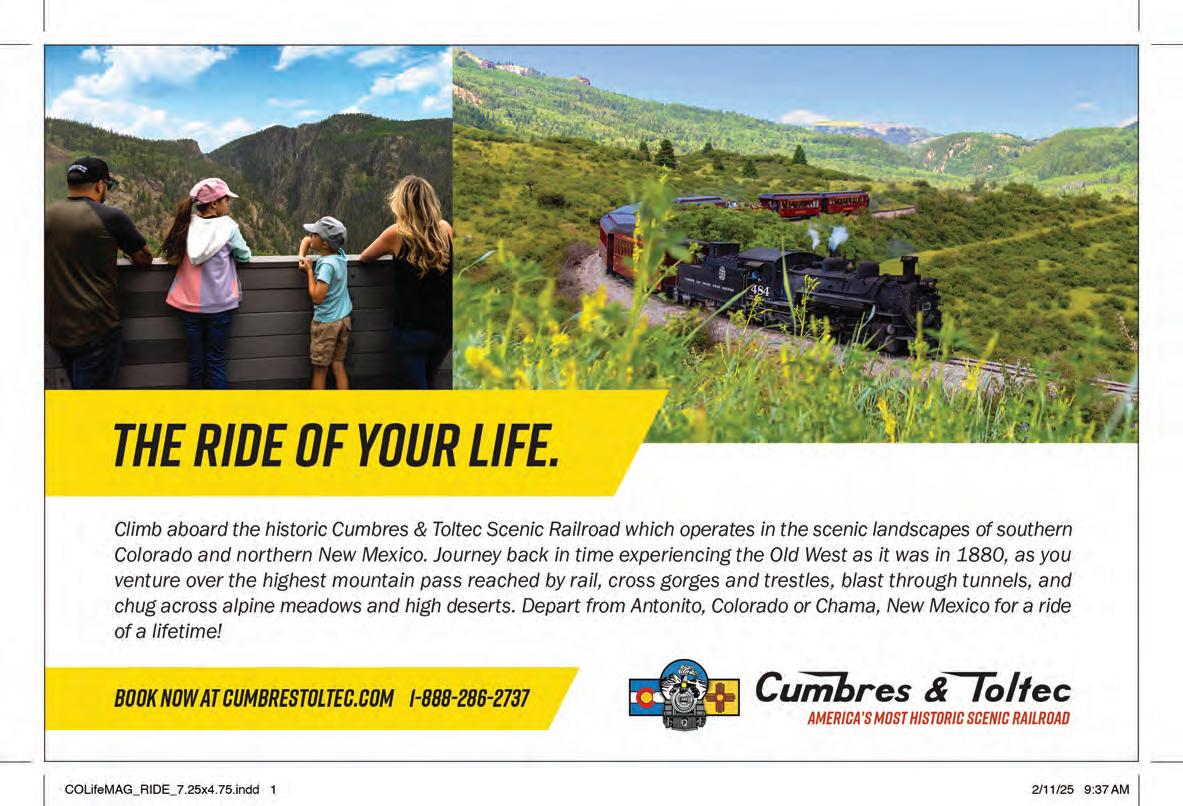



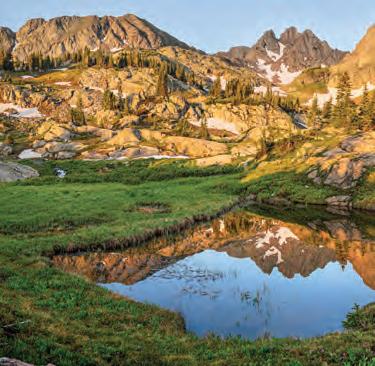

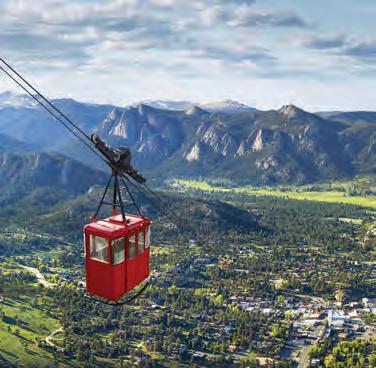
18 Tiny Flowers, Big Picture
A photo essay marries science and art to showcase Colorado’s overwhelming biodiversity – all within a single acre in Tabernash. story and photographs by Erik Makić
26 Unnamed and Untamed Vicariously venture into one of the state’s most rugged mountain ranges – the Gore Range. story and photographs by Dean Allen
40 The Iron Path
North America’s hardest via ferrata takes climbing to dizzying heights while threading through Ouray’s rich mining history.
by Ariella Nardizzi
46 Landmark Lift
The Estes Park Aerial Tram whisks passengers 1,060 feet to the summit of Prospect Mountain, just as it has for the past 70 years. by Eric Peterson
58 Rocky Mountain Folks Festival
The Rocky Mountain Folks Fest returns this August to the banks of the St. Vrain River in Lyons. by Peter Moore
A look back on President Theodore Roosevelt’s whirlwind train tour across Colorado in 1903; Yampa Valley Foods keeps fresh food flowing at a year-round indoor farmer’s market; and the Eastern Plains’ first craft brewery thrives in Sterling.


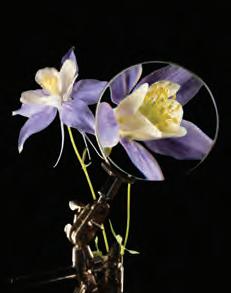
ON THE COVER
An aphid hides in the center of a columbine (Aquilegia vulgaris), the beloved state flower of Colorado. Story begins on page 18.
PHOTOGRAPH BY ERIK MAKIĆ
16 Trivia

Take a hike across Colorado’s state parks with this trekkingthemed trivia quiz. Answers on page 56 (no peeking!).
34 Poetry
The rising sun and pursuit of mountain peaks inspire this issue’s poetic ascent.
36 Kitchens
Hearty salads to fuel your summertime adventures.
52 Go.See.Do.
Paonia’s Cherry Days bring pit-spitting fun and a parade; Creede Repertory Theatre celebrates 60 years; plus 13 more must-see summer events.
60 Camping
St. Vrain State Park near Longmont offers an easy, accessible escape from the city.
62 Peak Pixels
Joshua Hardin captures the Western Slope’s best waterfalls –and shares how to photograph them.







MAY/JUNE 2025
Volume 14, Number 3
Publisher & Editor
Chris Amundson
Associate Publisher
Angela Amundson
Photo Coordinator
Erik Maki
Staff Writer
Ariella Nardizzi
Design
Mark Del Rosario
Lydia Paniccia
Tim Parks
Editororial Assistant
Savannah Dagupion
Advertising Sales
Sarah Smith
Subscriptions
Sheila Camay
Colorado Life Magazine
c/o Subscriptions Dept. PO Box 270130
Fort Collins, CO 80527
970-480-0148
ColoradoLifeMag.com
SUBSCRIBE
Subscriptions are 1-yr (6 issues) for $30 or 2-yrs (12 issues) for $52. Please call, visit NebraskaLife.com or return a subscription card from this issue. For fundraising and group subscription rates, call or email subscriptions@coloradolifemag.com.
ADVERTISE
Advertising deadlines are three months prior to publication dates. For rates and position availability, please call or email advertising@coloradolifemag.com.
CONTRIBUTE
Send us your letters, stories, photos and story tips by writing to us, emailing editor@coloradolifemag.com or visiting ColoradoLifeMagazine.com/contribute.
COPYRIGHT
All text, photography and artwork are copyright 2025 by Flagship Publishing, Inc. For reprint permission, please call or email publisher@coloradolifemag.com.

STAFF WRITER ARIELLA Nardizzi clipped into the Gold Mountain Via Ferrata in Ouray with a healthy mix of nerves and grit. Her guide, Clint Cook, offered a final piece of advice before they launched into North America’s hardest route: “It’s best to just not fall.”
She laughed. Then halfway across the infamous “Monkey Bars” – arms shaking, legs dangling above a few hundred feet of air – one hand slipped. Her guide calmly steadied the cable and pulled her back in. “Happens to everyone,” he said.
Colorado does that to you. It thrills you, humbles you and, if you’re lucky, teaches you something in the process.
This issue celebrates that spirit. Dean Allen takes us into the Gore Range backcountry where the trails are unnamed and the silence is untamed. Ariella Nardizzi relives the full-body test that is the Gold Mountain Via Ferrata. And Josh Hardin gives us a photo-driven excuse to chase waterfalls across the Western Slope – camera in one hand, towel in the other.

But adventure isn’t always defined by vertical gain or splash radius. Sometimes it’s slowing down enough to notice the tiny, perfect flowers blooming on a single acre in Tabernash. Sometimes it’s riding a cherry-red tram car up Prospect Mountain, watching the world shrink below without breaking a sweat. Or casting a line into a quiet pond at St. Vrain State Park, hoping for nothing more than a bite and a bit of peace.
Whether you’re a thrill-seeker, a trivia nerd, a music lover heading to Lyons, or just someone who likes waking up under a sky full of stars, this season offers a hundred ways to feel alive.
And if you find yourself out on a ledge this summer – metaphorically or otherwise – remember: it’s okay to slip now and then. What matters is that you clipped in, showed up and looked around.
Because this, right here, is the season for holding on – and letting go.
Chris Amundson Publisher & Editor editor@coloradolifemag.com


story by ARIELLA NARDIZZI photographs by BEN
DUKE
In Steamboat Springs, shelves brim with more than 1,500 locally sourced products – from meat and produce to jellies and baked goods. Yampa Valley Foods, a yearround indoor farmer’s market, opened its doors on 11th Street last fall, quickly becoming a vital link between Steamboat’s thriving resort scene and the agricultural roots of Northwest Colorado.
The Community Agriculture Alliance launched an online market in 2014 to connect producers with consumers directly. But the initiative soon outgrew its digital
beginnings – especially when the pandemic underscored the fragility of national food supply chains. Yampa Valley Foods seized the opportunity to create a more resilient, local food network by establishing a physical storefront downtown.
Today, the market works with more than 85 producers across Routt, Moffat and Rio Blanco counties, ensuring a steady, year-round supply of fresh food. Among them is Tyler Knott of Trout Creek Meats, who has sold beef and lamb through Yampa Valley Foods since 2021. His family’s roots in Oak Creek stretch back nearly 90 years. A fourth-generation rancher, Knott grew up working alongside
his father and grandfather and now continues the tradition with his two kids, Ella and Collin.
The family takes pride in their pasture-bred, hormone-free meats and prioritizes sustainable land management to ensure the ranch thrives for generations to come.
For Knott, Yampa Valley Foods provides a valuable, accessible link between producers and consumers – offering a familiar, market-style setting without requiring bulk purchases. “I’d put my lamb up against anyone’s,” he said, noting how quickly his lamb chops and ground beef sell out.
Housed in a stout red-brick building in

downtown Steamboat, the market exudes a rustic, welcoming atmosphere. Visitors are encouraged to become “Yampavores” – a term for those who consume food grown in the Yampa Valley.
The market’s mission is simple yet powerful: to give consumers a direct connection to their food – knowing exactly who produced it, where it was grown and how the land, animals and crops were cared for. “That’s the meat of what we do – literally,” said manager Katie Stanhope.
One of the market’s key benefits is extending the availability of items once limited to summer farmer’s markets – such as fresh greens from Mountain Bluebird Farm in Hayden. In the past decade, Yampa Valley Foods has generated more than $2.1 million in sales for local producers, with every cent going directly to them.
“We can’t lose the community’s agricultural heritage. These landscapes were used for food production long before skiing started here,” Stanhope said. As Steamboat balances its urban, rural, resort and agricultural identities, Yampa Valley Foods stands as proof that these traditions can thrive together.

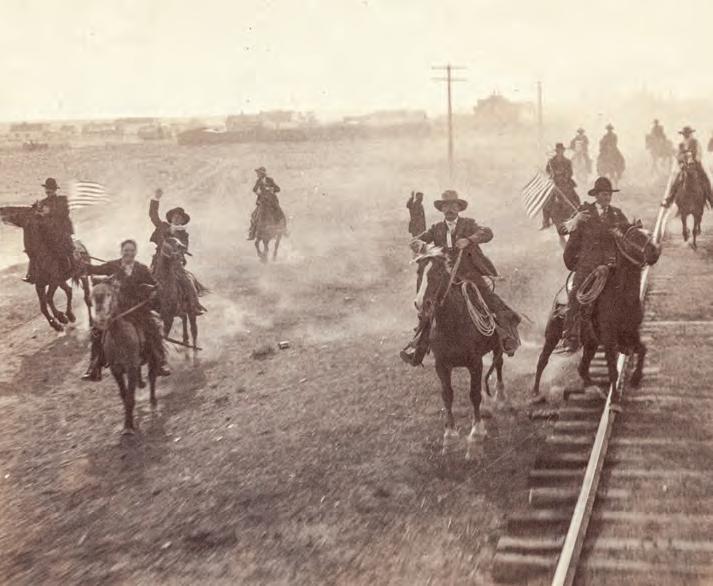

by RON J. JACKSON, JR.
The black-and-white image on the stereograph crackles with excitement and gratitude. Cowboys ride hard in clouds of dust, waving hats and small American flags as they chase a Union Pacific Railroad train. Their shouts of welcome nearly echo from the frame.
This wasn’t just any train.
The cowboys were chasing President Theodore Roosevelt’s train on May 4, 1903, during his sweeping tour of the West. The journey covered more than 14,000 miles across 25 states between April and June. Roosevelt spent the entire day of May 4 in Colorado, stopping for speeches in Denver, Colorado Springs, Pueblo and Trinidad.
One of the most heartfelt welcomes came early that morning in the small town of Hugo. More than 2,000 cowboys, stockmen and families greeted Roosevelt with a chuckwagon breakfast cooked over an open fire.
“They had kindled a fire and cooked a breakfast in expectation of my arrival,” Roosevelt later wrote to Secretary of State John Hay. “It seemed absurd to get off and eat at the tail end of a chuck wagon in a top hat and frock coat, but they were so heartbroken by my refusal that I finally did.”
Roosevelt held a deep affection for cowboys. In 1884, he lost both his wife and mother within hours. Devastated, he left New York politics and sought solace in the Dakota Territory, living among cowmen to work through his grief. He found camaraderie on the range – and later counted cowboys among his beloved Rough Riders in the Spanish-American War.
So, Roosevelt joined the men in Hugo for “pot luck,” then continued on to Denver, where he addressed a crowd gathered in front of the Capitol. He spoke of irrigated farms, new homesteaders and the resilient spirit of the West.
“I believe in your future because I believe you have just the right traits,” he told the crowd. “And therefore, my fellow citizens, my fellow countrymen, I wish you well ... I look forward with absolute certainty to seeing you make your great future infinitely greater than your past has been.”
Surely, Roosevelt had the spirited boys of Hugo in mind when he bellowed those words.

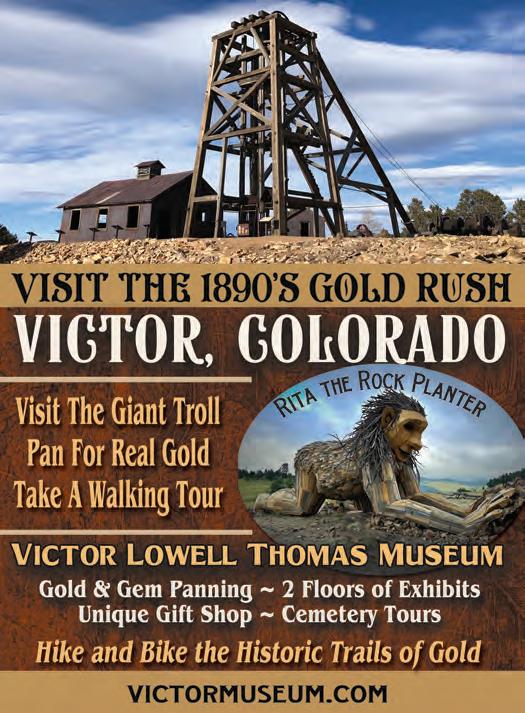

With a mechanic’s hands and a local harvest, Parts & Labor sparks a new beer culture on the plains
by ARIELLA NARDIZZI
For decades, Coors and Bud Light ruled the taps in Sterling. Patrons favored light lagers from big-name brewers while darker beers gathered dust. That changed in 2016 when Dylan and Kimberly Harford opened Parts & Labor Brewing Company on Main Street – the Eastern Plains’ first craft brewery.
The Harfords, both from Sterling, knew they had something unique to offer. They envisioned a brewery built on local pride, rooted in the land and powered by the hard work ethic that defines life on the plains.
Dylan’s love of brewing began 23 years ago when the couple lived in Fort Collins, a hub for Colorado’s craft beer scene. Then a Nissan technician, Dylan started homebrewing with a fellow mechanic – tinkering with recipes and learning by doing.
The couple returned to Sterling in 2008, and in 2016 they turned their hobby into a business. They transformed a 1925 Cadillac dealership – once Bill’s Motor Co. – into their brewery. The name, Parts & Labor, nods to Dylan’s background under the hood.
When they opened, six beers filled the taps. Today, they’ve tripled their brewing capacity and serve 12 rotating selections, from light kölsch to vanilla coconut porter to cherry sour. Kimberly dreams up bold flavor profiles; Dylan brews them into drinkable form.
Their customers have embraced the variety. “The locals have their spots worn into the bar tops,” Dylan said.
At first, only the lightest beer would do. But over time, locals graduated to IPAs and dark Russian Imperial Stouts. “We’ve seen beer culture evolve here. It’s been fun developing the local palate,” Dylan said.
While expanding tastes, the Harfords also champion Sterling’s agricultural roots. Their Haas local wheat beer has been a taproom staple since day one. In 2016, Dylan and their 5-year-old son

Parts and Labor Brewing in Sterling opened in 2016 as the Eastern Plains’ first craft brewery. Owners Dylan and Kimberly Harford now serve 12 rotating selections on tap, but are known for their Haas wheat beer which utilizes locally-harvested wheat.
hauled freshly harvested wheat in the back of a pickup, bagging it themselves for the first batch. The result was a crisp, approachable beer made entirely from Sterling wheat – a blend of brewing tradition and hometown agriculture that set the tone for everything that followed.
Parts & Labor continues to support the local food economy, sourcing all its meat and produce within 75 miles from northeastern Colorado farms.
The brewery’s impact has rippled through Sterling. It’s become a gathering place downtown, drawing after-work regulars and weekend travelers who bring a
jolt of shopping energy into the downtown business district.
Their son, now 13, busses tables and chats with regulars. “He used to ride his tricycle around the brewery – now he’s helping out during service,” Kimberly said, noting how their child has grown alongside the business.
Between brewing batches, Dylan pours pints and checks in with customers, catching up with regulars and welcoming newcomers. It’s a rhythm that feels less like managing a business and more like hosting a well-attended neighborhood gathering – one pint at a time.



Step into this trivia trek across Colorado by BEN KITCHEN
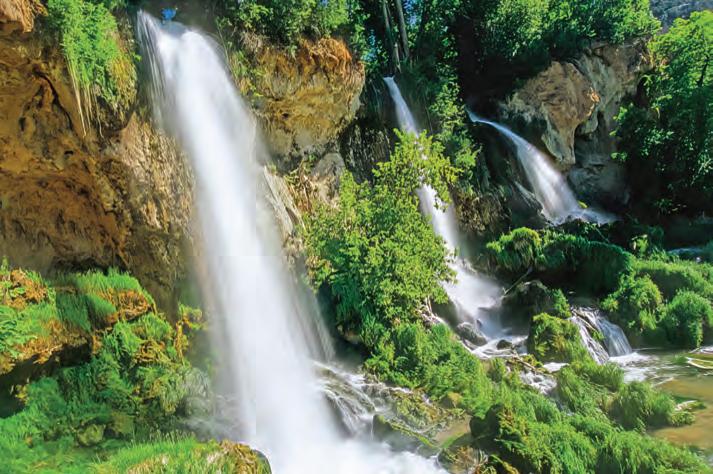



1 Rifle Falls State Park’s Bobcat Trail leads to what kind of state-run facility, one of 19 in Colorado, known for producing “fingerlings and catchables”?
2
Cheyenne Mountain State Park regularly offers guided nature hikes exploring local flora. What floralthemed word precedes “Wednesday” in these weekly outings?
3
Sylvan Lake State Park officially has two trails: Lake Shore Loop and West Brush Creek Trail. But the Sneve Gulch Trail enters the park from what neighboring national forest named after a river?
4 According to Colorado Parks & Wildlife, which northern Colorado state park boasts the most trail mileage – 136 miles, more than triple Mueller State Park’s total – and is also the largest state park?
5
North Sterling State Park offers a very short trail (under 700 feet) leading to a notable rock formation described by what eightletter adjective, suggesting perfect equilibrium?
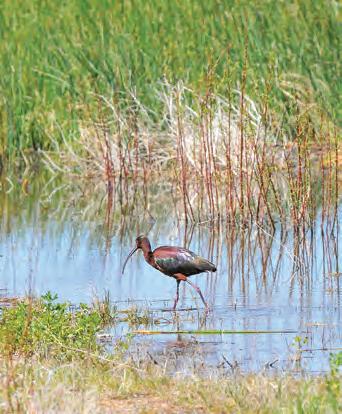
6
Navajo State Park sits along the border between Colorado and what neighboring state? Its Sambrito Wetlands Trail brings hikers within 140 feet of the state line.
a. New Mexico
b. Utah
c. Wyoming
7
One of Stagecoach State Park’s trails, Public Lands Access Trail, closes annually for three months. Why?
a. Elk habitat preservation in winter
b. Dangerous mud season conditions
c. Seasonal farmers markets
8
Veterans, active military and National Guard members enjoy a fee-free hiking day at all Colorado State Parks on Veterans Day, which occurs in which month?
a. October
b. November
c. December
9
James M. Robb Colorado River State Park’s Connected Lakes section has several bird-themed trails. Which of these is not a real trail name?
a. Kingfisher Trail
b. Loon Walking Trail
c. Osprey Point Trail
10
John Martin Reservoir State Park offers only one hiking trail, which is just over 4 miles long. What is the trail’s name?
a. Blue Rib Trail
b. Green Skull Trail
c. Red Shin Trail

11
Eleven Mile State Park, surrounding Eleven Mile Reservoir, coincidentally has slightly more than 11 miles of trails.
12
Due to proximity to Denver, Barr Lake and Chatfield state parks have very limited bird populations because city noise drives them away.
13
Visitors to Castlewood Canyon State Park east of Castle Rock can hike to the ruins of a dam that burst in 1933, sending 1 billion gallons of water and logs into downtown Denver.
14
Dogs are permitted on every hiking trail in all Colorado state parks.
15
Cherry Creek State Park visitors hiking Cottonwood Creek Trail can extend their outing with a short walk along West Lake View Road to Suhaka Field, a designated area for flying model airplanes.


Experience historic charm at Frisco Lodge. Our exceptional hospitality, a ernoon wine and cheese, award winning courtyard, outdoor hot tub and romantic replace are just a few reasons our guests rated us the #1 bed & breakfast in Frisco and all of Summit County!
See why our guests think we are the best
No peeking, answers on page 56.
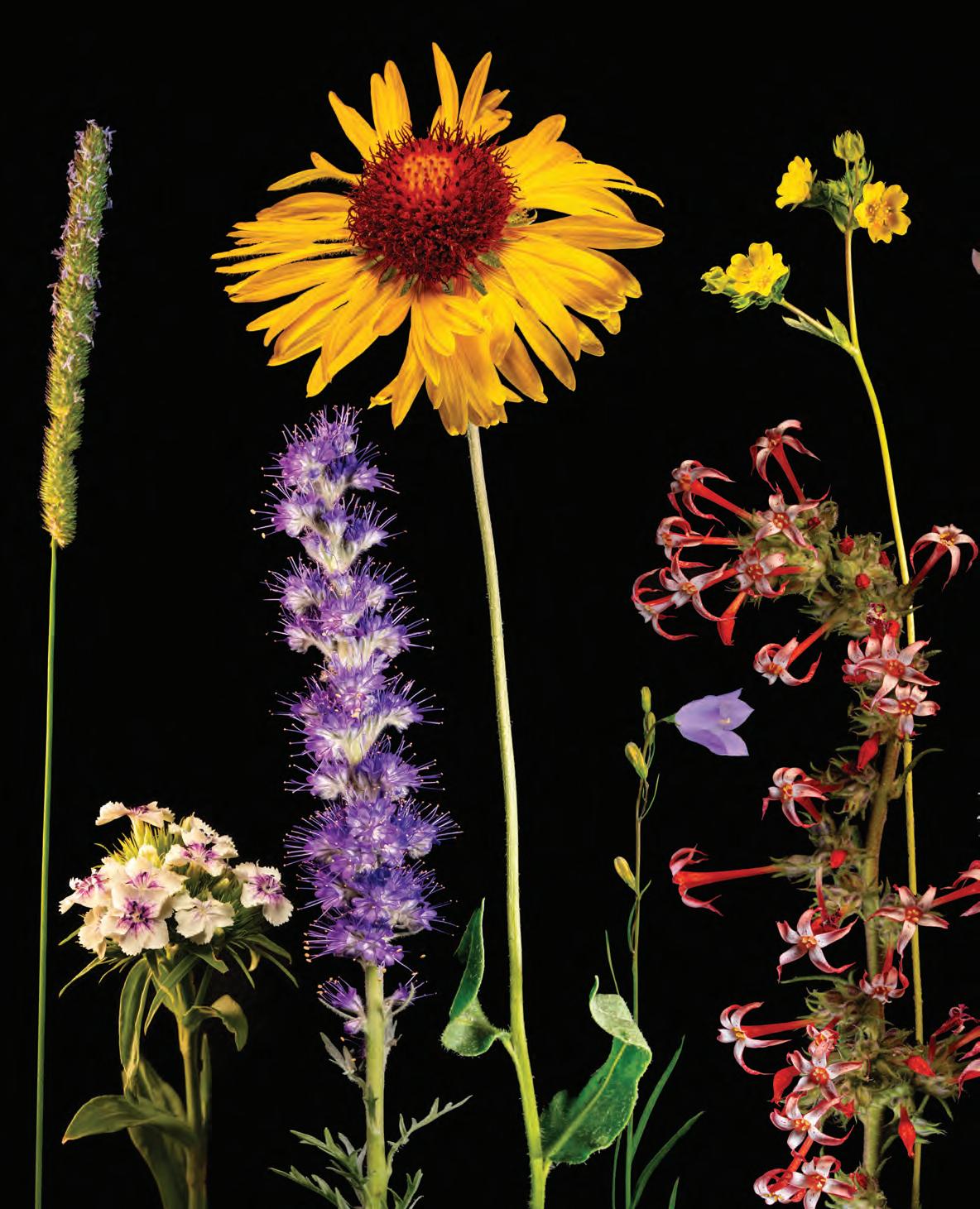

photos and story by ERIK MAKIĆ as told to ARIELLA NARDIZZI
My goal with photography has always been to marry science and art for education. In May 2024, I thought, why not photograph every flower I can find on my parents’ oneacre land in Tabernash? Initially, I photographed familiar flowers like Colorado columbine (Aquilegia caerulea), black-eyed Susan (Rudbeckia hirta) and mountain harebell (Campanula rotundifolia). But the more I explored, the more unknown plants I discovered, such as twinberry honeysuckle (Lonicera involucrata) – 54 species in total.
‘Backyard Transect’ is about biodiversity. I’m documenting how much truly grows on a small plot of land. I didn’t limit myself to native plants; I photographed everything, including invasives, because that’s the true picture.
I love small flowers because I can get super macro with them. They’re often overlooked as we walk toward larger, more obvious flowers. But pause to look closely and these tiny blooms, just millimeters wide, are everywhere. We also have a vibrant, thriving patch of eight columbine bushes, Colorado’s state flower, growing along our driveway.
Some flowers’ lifespans are fleeting. If I saw a flower one day and couldn’t photograph it, it might not be there the next – eaten or blown away.
I took my 94-year-old Baka – Serbo-Croatian for Grandmother – in a tiny side-by-side car we use for plowing snow.
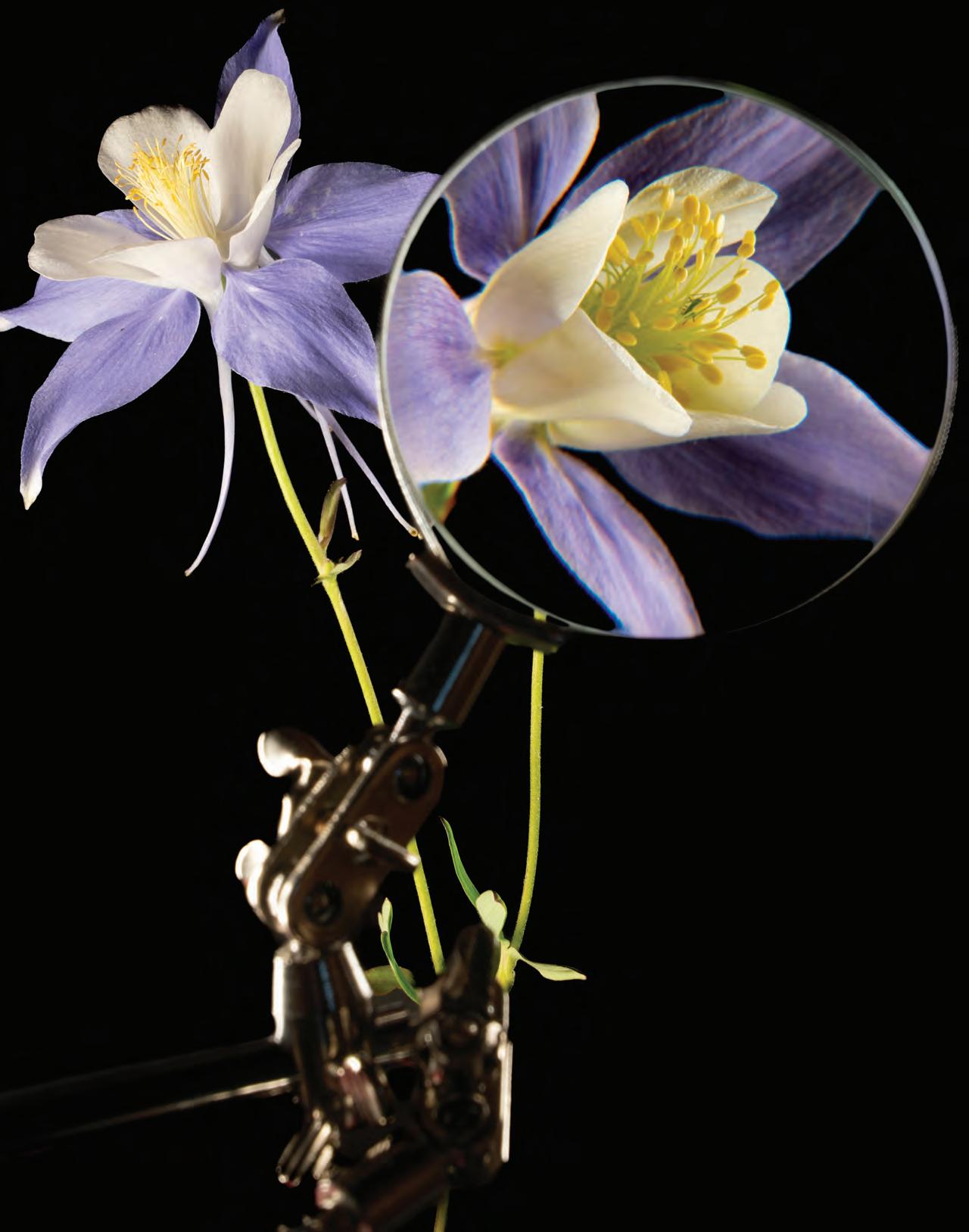
She would spot flowers from the driveway and I’d check if I had photographed them. She sometimes saw things I missed. Multiple pairs of eyes are essential for finding all that biodiversity. After photographing, I made bouquets for her to enjoy.
I was careful not to encourage irresponsible behavior. Columbines are illegal to pick on public land, so I only cut flowers on our private property. I always ensured multiple plants remained, selecting a single “ideal specimen,” so I wouldn’t need to cut any more.
If there was only one flower, I left it to continue growing. I also only took one or two flowers at a time so they wouldn’t wilt quickly, allowing me to focus fully on capturing the image.
After cutting, I took the flowers indoors. Using a microwave-sized box lined with black paper inside an old TV cabinet, I created a small studio. For lighting, I used two external lights – one that can change colors to enhance the flowers’ character – and turned off all other lights. Shooting with my camera on a tripod, my shutter speeds ranged from one-fourth second to a full second. Everything was captured on my trusty 24–105mm f/4 lens at f/22, ensuring the entire plant stayed sharply focused.
I also used a magnifying glass with small metal arms and clips – usually for tying fly-fishing flies or assembling circuit boards – to magnify flower centers, highlighting the contrast between actual size and close-up detail.
In one columbine photo, I noticed a tiny green bug at the flower’s center only during editing. Such discoveries were delightful surprises throughout the project.
I’ve loved biology since middle school. At Colorado State University in Fort Collins, the environment was always my priority. I got my first camera to document studying abroad in southern Chile with the School for Field Studies. There, I learned the power of storytelling through photography – captivating others to engage with scientific insights.
I graduated with a bachelor’s in bio-
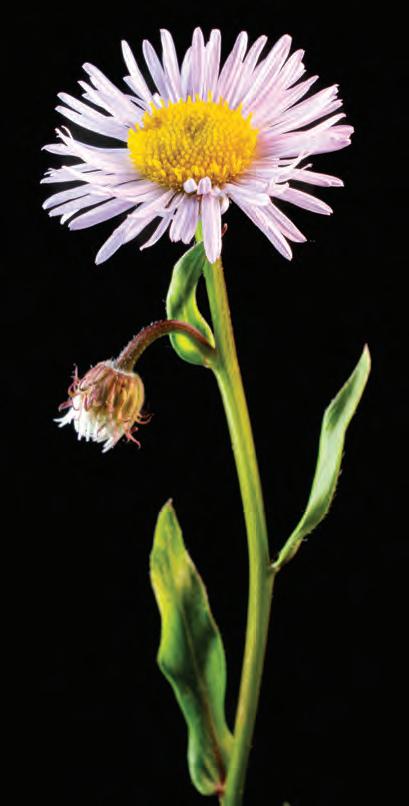
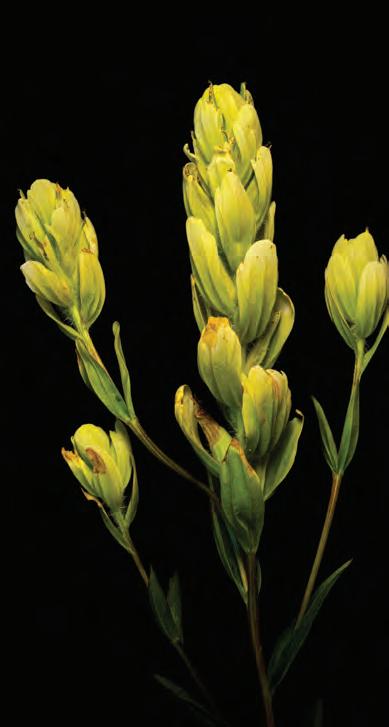
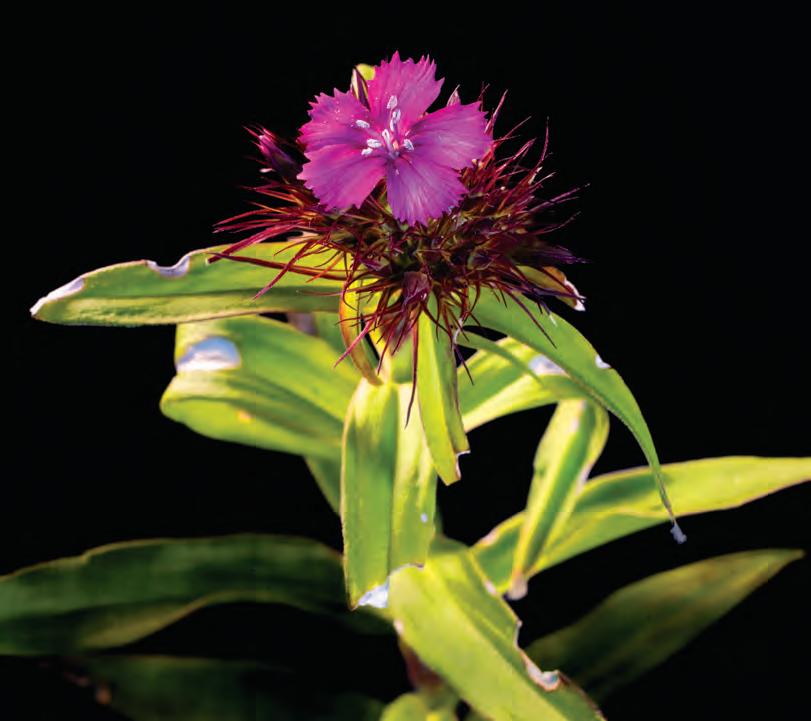
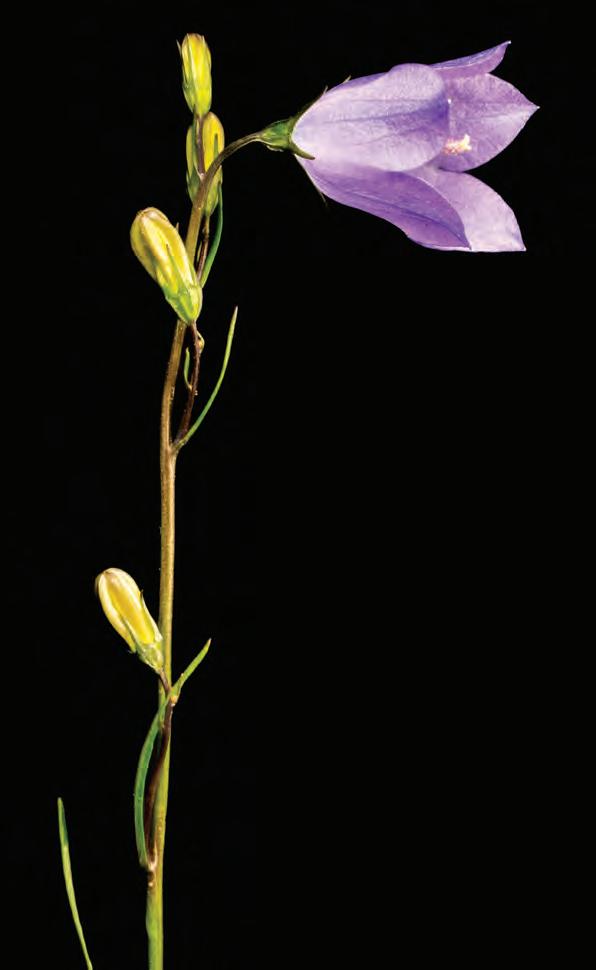



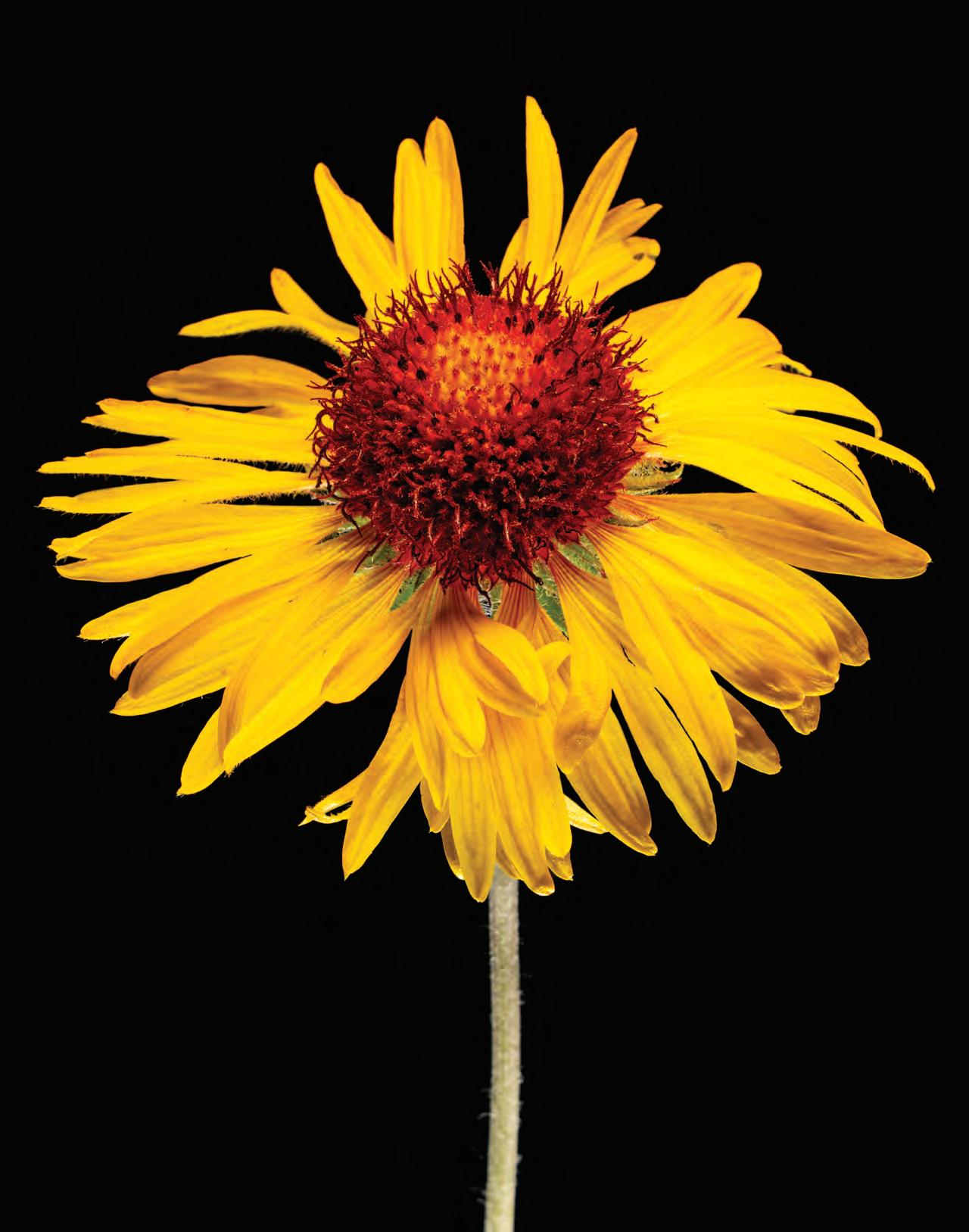
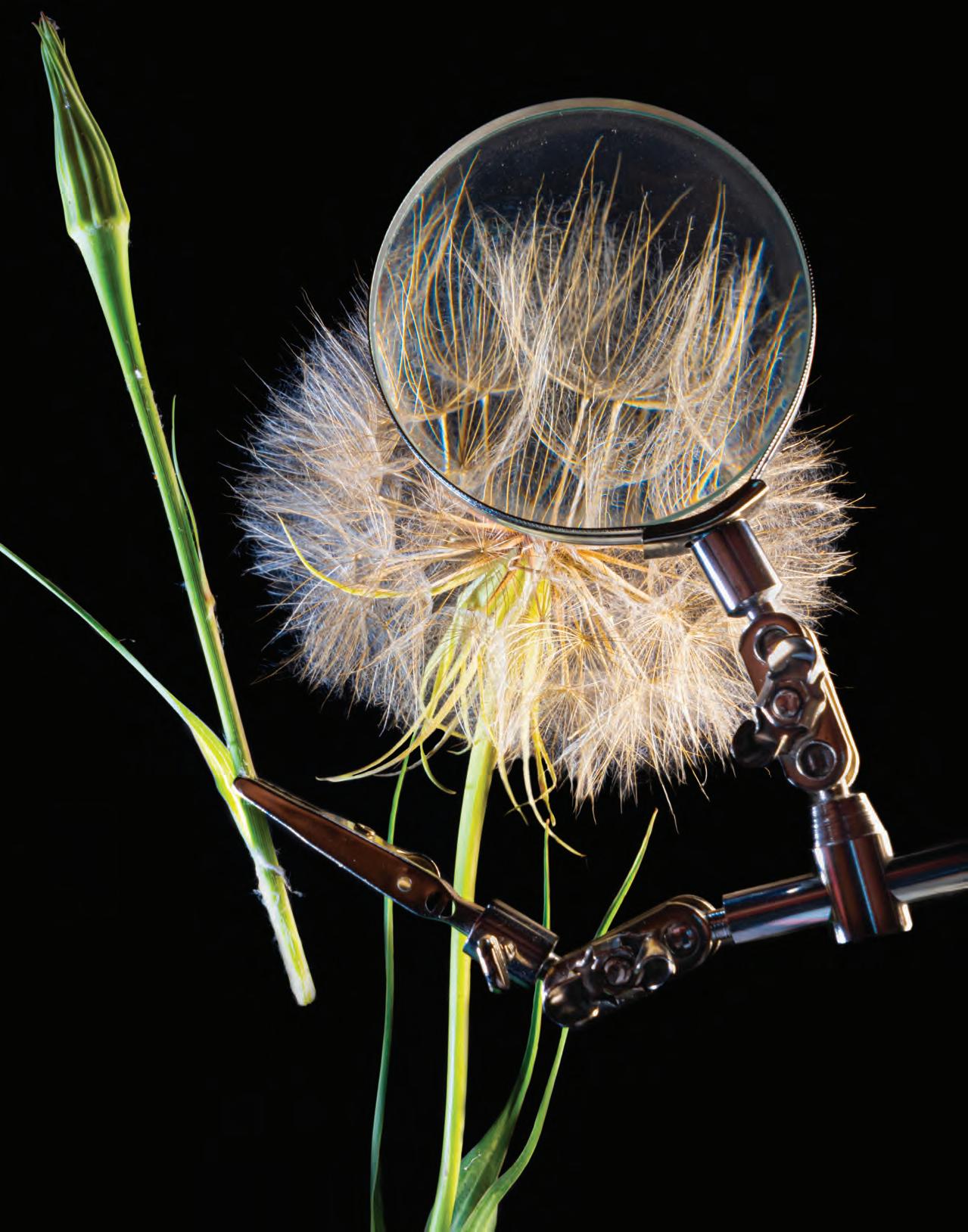


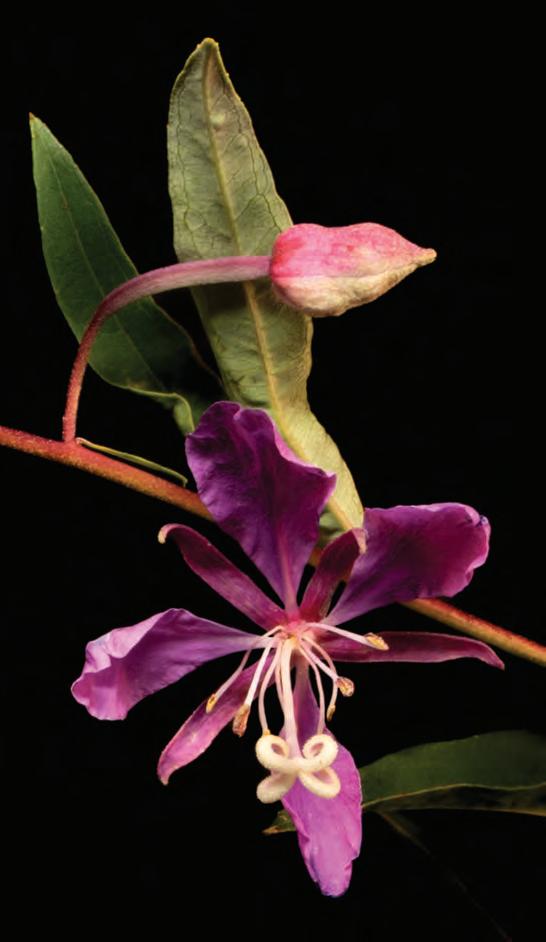
logical science, then earned a master’s in multimedia and photography at Syracuse University’s Newhouse School. My experience abroad remains my North Star: engaging curiosity with images to educate.
I decided to photograph everything in this project to represent both the good and the bad. Colorado’s ecosystems evolved together over time – each plant, insect, animal and fungus plays a role in balance. However, invasive species like scentless chamomile (Tripleurospermum inodorum) and ox-eye daisy (Leucantheumum vulgare) from Europe disrupt ecosystems because they lack natural predators or checks and balances.
To combat invasives, plant diverse native
species suited to your climate zone. With care, these native plants can rebuild ecosystems, eventually sustaining themselves.
Documenting Colorado’s complete flora statewide would be overwhelming –dry plants, mosses, lichens, hundreds of species. But even in my small corner of the state, seasonal drama is vivid. A wet spring yields certain flowers, while a dry summer brings others, like fireweed (Chamerion angustifolium) – the first plant to return after a fire.
Now, I’m constantly looking for new flowers. This project deepened my appreciation for the incredible biodiversity right here in my backyard.”
About the Author: Erik Makić is the photo coordinator for Colorado Life, where he commissions and edits wildlife, landscape and environmental photography. He holds degrees from Colorado State University and the Newhouse School at Syracuse University. Before joining Colorado Life, he completed an 18-month contract as a photo production coordinator at National Geographic in Washington, DC. Now based in his hometown of Arvada, Makić combines his background in biology and visual storytelling to highlight the beauty and complexity of the natural world.

STORY
PHOTOGRAPHS BY DEAN ALLEN
The Gore Range is one of the most rugged mountain ranges in the state. At least 19 summits exceed 13,000 feet and more than 50 peaks reach over 12,000 feet across the 1,420-squaremile wilderness.
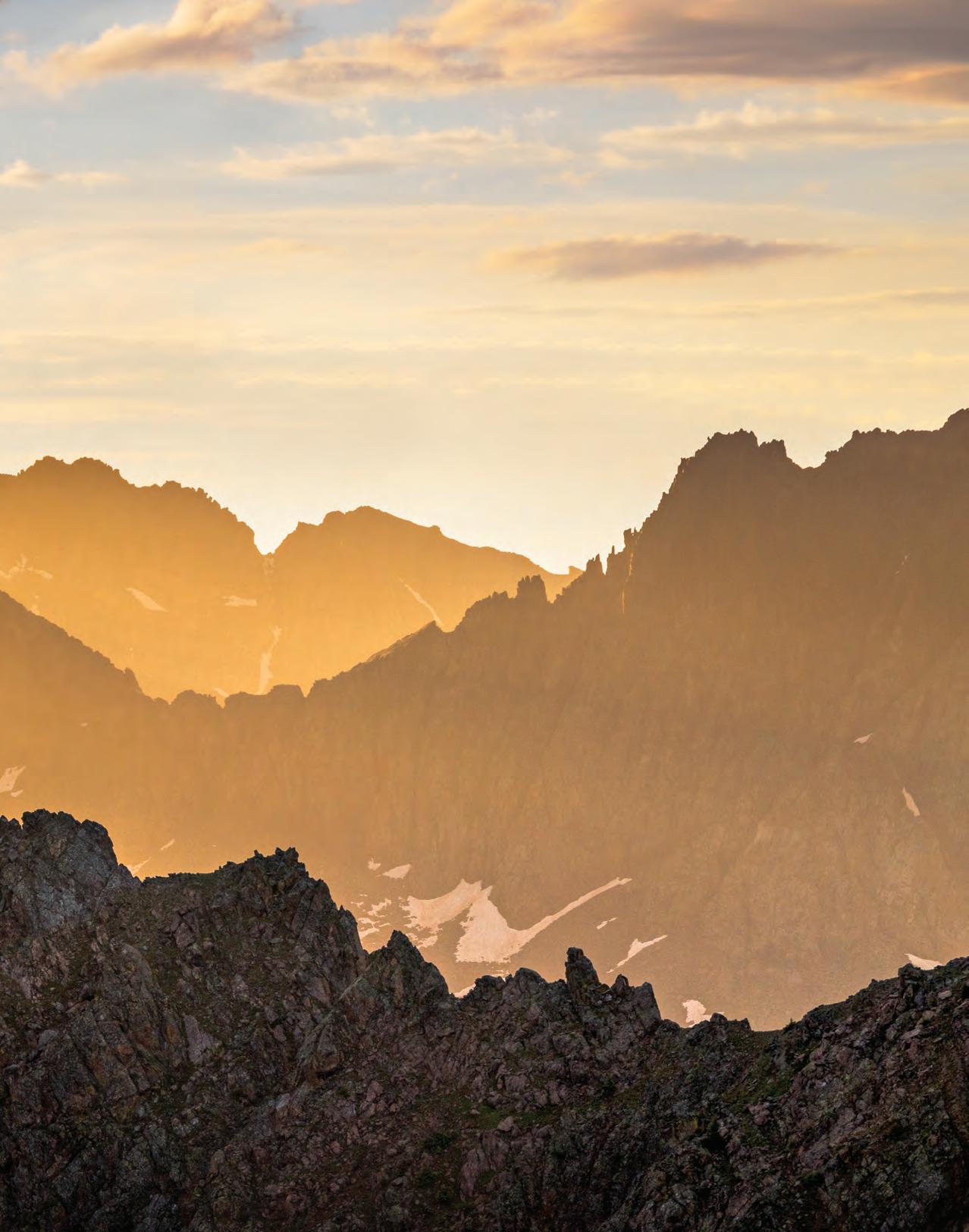
AF T ER THE CRACK of lightning ceased and the summer rain dissipated, I was enveloped by a dance of light and mist across what nature photographer John Fielder called “one of the two most rugged mountain ranges in Colorado.”
Nestled deep in the Eagle’s Nest Wilderness, I felt like a tiny eaglet in a giant’s nest, perhaps in Middle Earth.
Night was swallowing daylight when I photographed the dark gorge dominated by a small peak rising from its depths. In a range spanning 1,420 square miles, boasting more than 50 mountains over 12,000 feet and at least 19 summits exceeding 13,000 feet, this modest, unnamed summit captured my imagination most. I wished I could tiptoe onto its mysterious peak.
I love the Gore Range. Extending north from Silverthorne and Vail, it’s a sprawling maze of serrated ridges, inaccessible drainages, solitude and raw beauty. It remains a true wilderness largely untouched by humans. Early Colorado miners found little of value there, leaving the slopes free from mine tailings or deteriorating jeep trails. None of its peaks surpass the coveted 14,000-foot threshold nor are they among Colorado’s highest hundred summits. Instead, these mountains are closely interlinked by high ridges – none overshadowing another. It is quiet, unassuming – too rugged for casual tourists and not glamorous enough for fame-seekers.
Early explorers and cartographers in Colorado attempted to tame this wilderness with names that glorified politicians and influential citizens.
Dwarf Pyramid (right) is nestled in the Black Creek drainage, one of the most inaccessible locations in the continental U.S. It requires climbing to 12,200 feet and navigating permanent snowfields.

– BOB HAWKE


Names matter deeply to us even if the earth itself might prefer anonymity. In 1868, when Rocky Mountain News founder William Byers casually referred to “Gore’s Range,” the name stuck. Byers referenced Lord St. George Gore, an Irish baron whose infamous expedition slaughtered thousands of elk, deer, antelope, bison and bears. Despite Gore’s brutal legacy, his name soon appeared on maps and official documents.
In 2020, Summit County proposed renaming the range to Nuchu Range, meaning “Ute’s Range.” This initiative, now under review by the U.S. Board on Geographic Names, was inspired by Leon Joseph Littlebird who calls himself “the most native Coloradan you’ll ever talk to” as his Navajo and Ute ancestors “had already been here for 10,000 years.” That’s impressive yet barely registers on geologic scales.
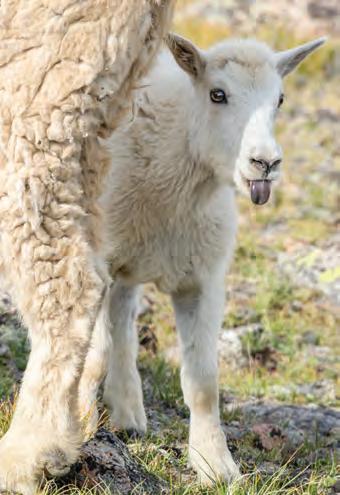
Littlebird argues that Gore’s violent legacy against wildlife and his alienation of almost everyone he encountered disqualify him from the honor of a mountain range bearing his name. Indeed, Gore fails the USGS criterion that names should “appropriately reflect our country’s history and values of environmental stewardship.”
Martin J. Smith, author of The Confounding Case of Sir St. George Gore, aptly summarized Littlebird’s preferred resolution: “Leave. No. Trace.”
Despite this controversy, Gore’s notorious influence never truly penetrated the heart of this range. To this day, only a few summits have official USGS names. Topographical maps list elevations of high points free from names. But these summits weren’t destined to remain anonymous indefinitely. Every year, unofficial names quietly attach themselves to these enigmatic peaks.
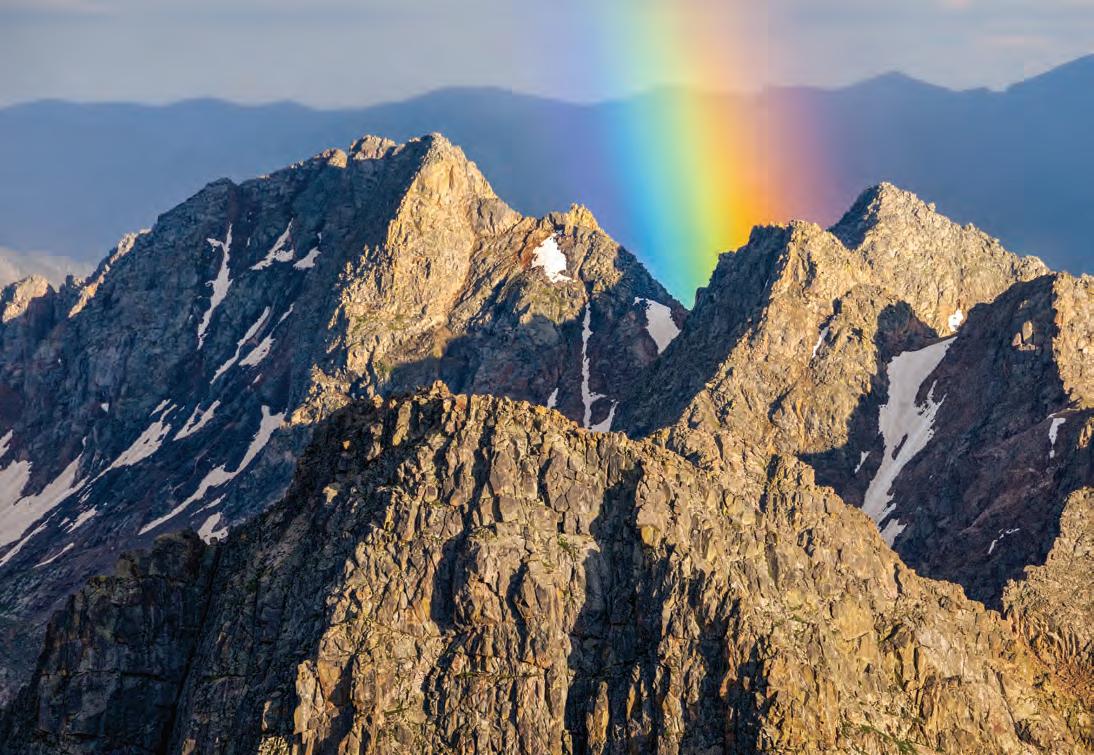

NAMING IS THE FIRST step to chasing away mystery. Once a place has a common language, explorers communicate their findings, eventually eroding the unknown. In Roof of the Rockies, William Bueler describes how climbers Carl Erickson and Edmund Cooper began lettering Gore’s peaks from A to Z, north to south, starting in 1932. Manifest destiny continues –which doesn’t feel great to me.
Still, contemporary explorers appreciate this naming system as it provides a practical entry point to the Gore Range’s complexities. If you know your ABCs, personal blogs and forums offer unofficial route descriptions not found on standard maps or guidebooks, making these peaks more approachable – not necessarily easy but doable. However, knowing that my photo-
graphed peaks are labeled L, R, Q, W and X-Prime makes them feel somehow smaller. Replacing mystery with knowledge has its trade-offs, prompting many Gore adventurers – myself included – to hesitate before revealing too many secrets. Read on at your own risk.
Remember the tiny peak in the black gorge? Now, I know its unofficial name and how to reach it. Hidden deep in the aptly named Black Creek drainage is the Dwarf Pyramid. It’s a fitting name though perhaps I’d have been happier in ignorance.
One blog declared Black Creek drainage among the most inaccessible locations in the lower 48. The most “reasonable” access involves navigating a 12,200-foot saddle with permanent snowfields on
both sides, followed by descending one to two thousand feet depending on your desired isolation. Avoid sudden cliff bands. (Climbers casually call this pass “Knee-Knocker Saddle.”)
Another approach requires a multi-day bushwhack from the east. Some maps hint at an abandoned 1930s Civilian Conservation Corps (CCC) trail, confirmed by scattered blog accounts.
However, one hiker suggested the forest service deliberately obscured the route. Should you locate it, continuing your bushwhack after the trail vanishes eventually leads to cliffs requiring Class 3 and 4 climbs, pristine alpine lakes – and the Dwarf Pyramid.
It continues to call me, whether it knows its name or not.


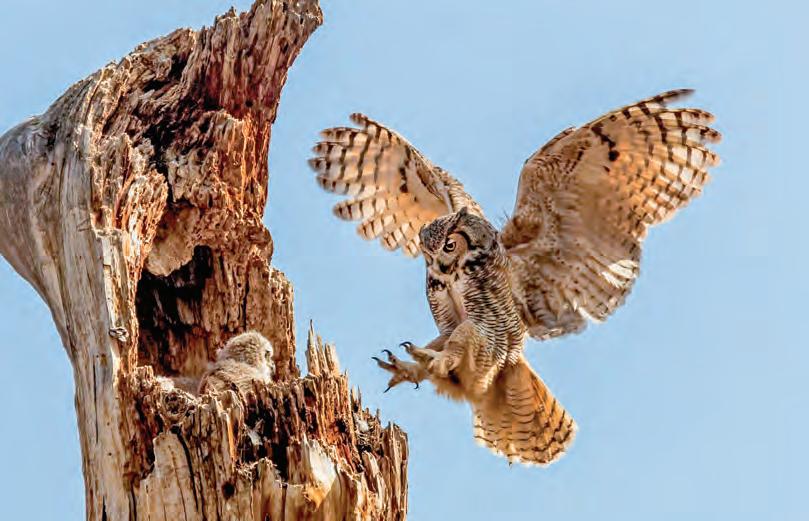
Dawn Key
The sun climbs higher, stretching its light across blossoming hills and open skies. Summer breathes warmth into the land and invigorates our poets as they, too, ascend in pursuit of clarity and a new perspective.
Norman W. Holden, Conifer
The gradual slope tricks the mind, As steepened paths lay behind.
Muscles burn, lungs call for peace, The distant peak is just out of reach.
A second wind fuels the rush, For vistas awaited, a scene so lush.
Satisfaction from the climb, The highest reward, pure and fine.
Returning to earth, a new quest to start, With visions of peaks held close to heart.
Ascending is life’s grand art, Each climb is a lesson, a fresh new start.
Vaughn Neeld, Cañon City
Ascending the air currents, the vultures glide on finger-tip wings, riding higher and higher, awash in the joy of flight. How delightful it must be to spread wings and glide, rising, ever rising, until everything below shrinks into a patchwork of browns, greens, yellows, and then to swoop down, dropping, ever dropping, while the earth rushes upward and the wind catches you, cradles you softly in the Mother’s arms.
Janice Volz Schefcik, Centennial
Climbing icy rocks
Steady slow steps to the top Stunning beauty waits.
Suzanne Lee, Littleton
A hawk, pale feathers roughing the quiet morning air, plunges from a branch over my head, digs deep with arm-wide wings climbs out of the dip of its launching, shocks me with the rich rush of intimate, unexpected sound and presence. A mouse would know to watch for predators above. A single feather drifts to the path, attests to the explosion of departure.
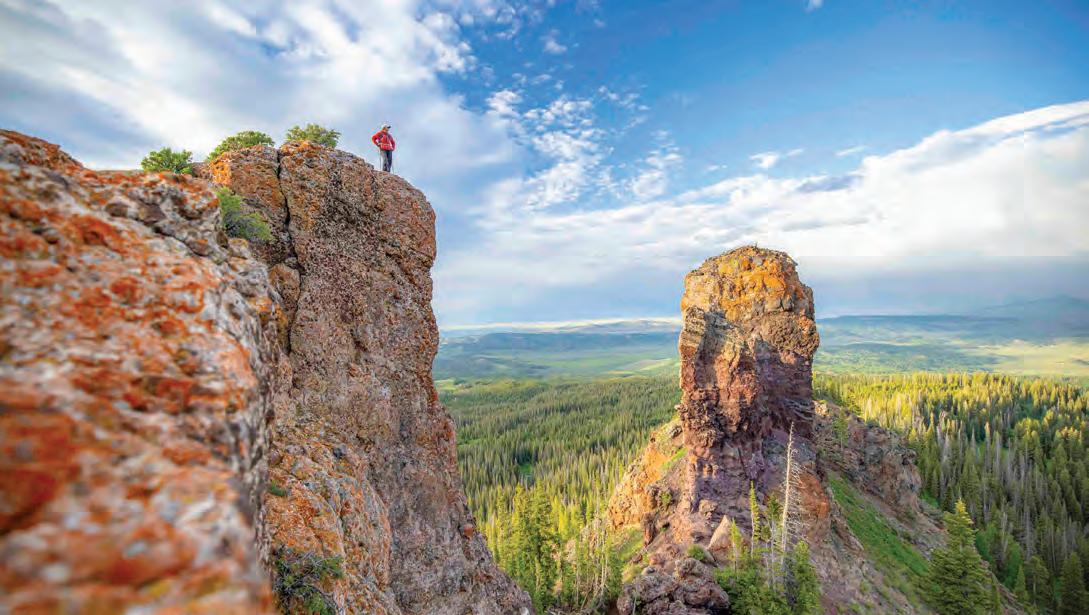
Steven Wade Veatch, Kingsley, Michigan
Sky-bound ridges beckon, drawing the Earth into sharp relief, each peak a timeless mystery etched in stone.
Granite boulders pierce the clouds, their solemn silence roaring like thunder, their immensity carved by the breath of time.
Pine forests unfurl, rooted deep, while alpine lakes reflect the heavens with clarity unsurpassed.
Faintly gleaming in forgotten veins, gold murmurs of a bygone frenzy, yet the mountains endure, unyielding to the grasp of greed.
This is the land of rising –where the damp soil breathes renewal and birdsong arcs toward open skies; where rivers leap from cliffs, their spray soaring toward light.
As you climb, the trails coil upward, the air thins to whispers, each breath a praise to the heights, each view a call to reach beyond. Colorado – where the mountains stretch skyward, and our spirits follow, ever rising.
Robert Basinger, Rifle
Because what goes up…
Getting back down safely was going to be the hard part after six hours on the trail and several thousand feet of elevation gain.
The trail like a dear friend, the summit as a siren call a granite stair-master cloaked in ambient light decked with autumns first snow with the sun sinking low.
A million steps a million breaths one for the kid I used to know.
A yearly ritual, a personal challenge legs completely spent on the descent.
Send Your Poems on the theme “Evergreen” for the November/December 2025 issue, deadline Sept. 1 and “Stillness” for the January/February 2026 issue, deadline Nov. 1. Email your poems to poetry@coloradolifemag.com or mail to the address at the front of this magazine.

These salad recipes are hearty enough to entice even diehard meat eaters
recipes and photographs by DANELLE
McCOLLUM
THE WORD “SALAD” originated in ancient Rome. Its root is the Latin word “sal,” meaning “salt,” referring to the simple seasoning the Romans favored. The past two millennia have seen salads evolve into far more complex and delicious forms, including some hearty variants that transcend salad’s lightweight reputation. This trio of salads feature pasta, corn and beans to provide needed nourishment to fuel summer adventures.
Just six ingredients – diced tomato and cucumber over pasta with olive oil, Greek seasoning and mayonnaise – make this a quick side dish for almost any meal.
Cook pasta according to package instructions. Rinse with cold water and drain. Add pasta to large mixing bowl and toss with olive oil and 1 teaspoon of Greek seasoning. Gently stir in tomato, cucumber, mayonnaise and remaining Greek seasoning and mix until combined. Season with salt and pepper, to taste. Refrigerate at least one hour before serving.
16 oz rotini pasta
2 tsp olive oil
1 Tbsp Greek seasoning, divided
2 cups diced cucumber
2 cups diced tomato
1 cup mayonnaise Salt and pepper to taste

Corn kernels cooked in butter and brown sugar form the base of a warm salad that will redefine the taste of summer.
Carefully remove corn kernels from cob. In large skillet, melt butter over medium heat. Add corn kernels and brown sugar and stir to combine. Season with salt and pepper. Add 1/4 cup water to skillet. Cook over low heat, stirring occasionally, until most liquid has evaporated, about 10 minutes. Transfer corn to large serving bowl and let cool for a few minutes. Toss basil, mixed greens and lemon juice into corn. Drizzle with balsamic vinegar and serve immediately.
10-12 ears fresh corn, shucked
1/4 cup butter
2 Tbsp brown sugar
1/4 cup water
Salt and pepper to taste
2 cups mixed greens
1/4 cup fresh basil leaves
1-2 Tbsp lemon juice
1-2 Tbsp balsamic vinegar
This protein-packed salad mixes beans with veggies, herbs and vinaigrette for a combination that will keep for days and keep you running.
Whisk together the ingredients for the vinaigrette and set aside. Blanch the green beans in boiling water until just tender, 3-4 minutes. Transfer to a bowl of ice water; drain.
Combine the remaining ingredients in a large bowl. Add green beans and toss to mix. Stir in vinaigrette and mix gently to coat. Refrigerate until serving.
Vinaigrette
1/4 cup purchased olive tapenade
3 Tbsp white wine vinegar
2 Tbsp olive oil
1 clove garlic, minced
1/2 tsp Dijon mustard
Salt and pepper to taste
Salad
8 oz fresh green beans, trimmed and halved
2 (15 oz) cans cannellini beans, rinsed and drained
1 cup halved grape or cherr y tomatoes
1/2 cup diced mozzarella cheese
1/2 cup thinly sliced pepperoni
1/2 cup sliced pepperoncini
1 6.5 oz jar marinated artichoke hearts, drained
2-3 Tbsp chopped fresh parsley

The editors are interested in featuring your favorite family recipes. Send your recipes (and memories inspired by your recipes) to editor@coloradolifemag.com or mail to the address at the front of this magazine.
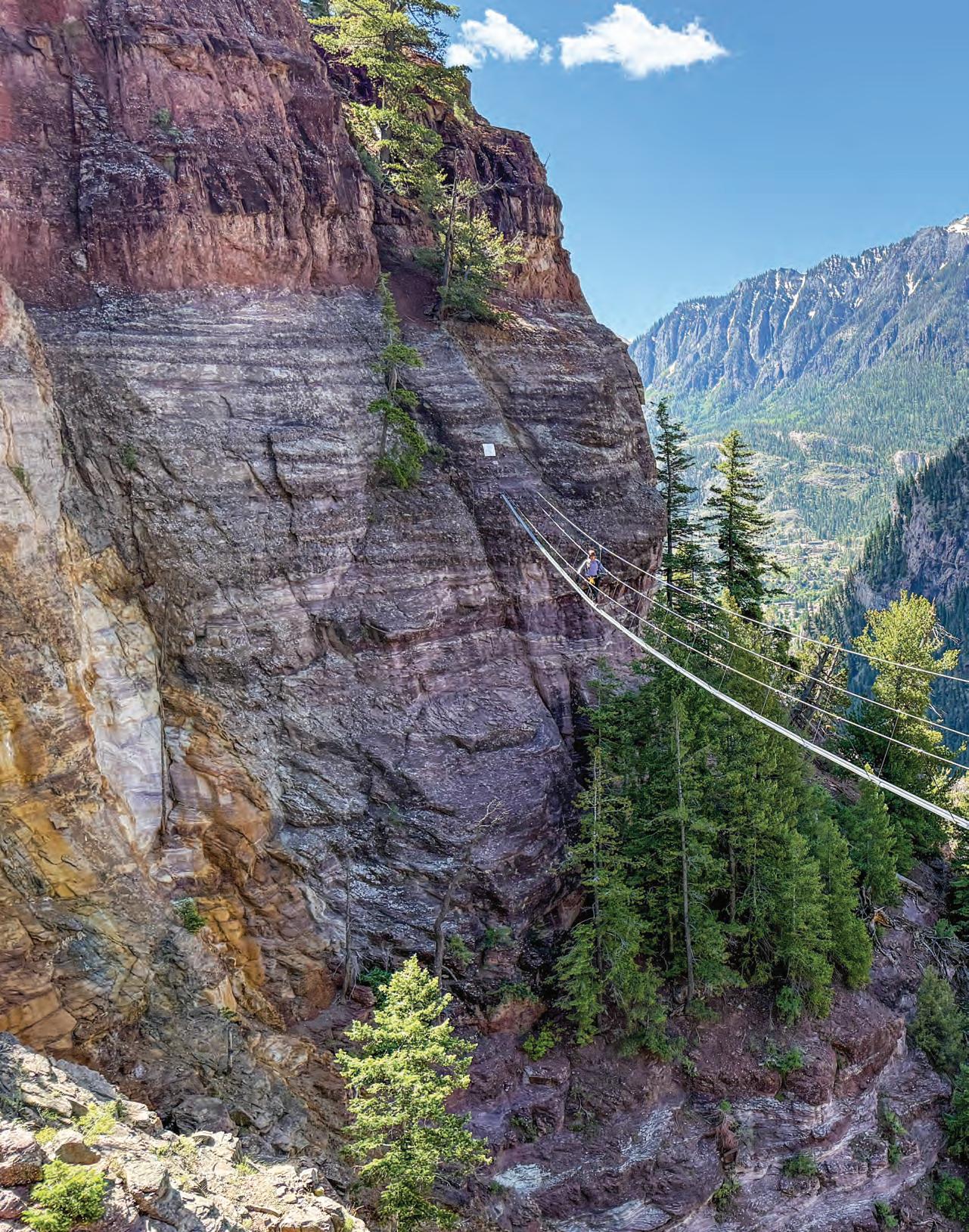
Ouray is home to the Gold Mountain Via Ferrata – North America’s hardest route
by ARIELLA NARDIZZI
IRON RUNGS BIT into my sweaty palms as I dangled above a hundred feet of open air. Below, Gold Mountain’s chossy cliffs fell into the pine-cloaked folds of Ouray –“Switzerland of America,” they call it – but all I could see was the next rung.
The section known as the “Monkey Bars” is the hardest pitch of any via ferrata in Colorado, even in North America. Just like the playground feature I loved as a kid – except here, the stakes were iron, granite and gravity. I gulped back fear as the ground inched closer on tired arms.
Stretching toward the next hold, the world narrowed to the deep, echoing thrum of adrenaline. When I karate-kicked my feet off the wall, one hand slipped and I braced for a plummet that never came. My cool-headed mountain guide, Clint Cook, swung in and hauled me to safety.

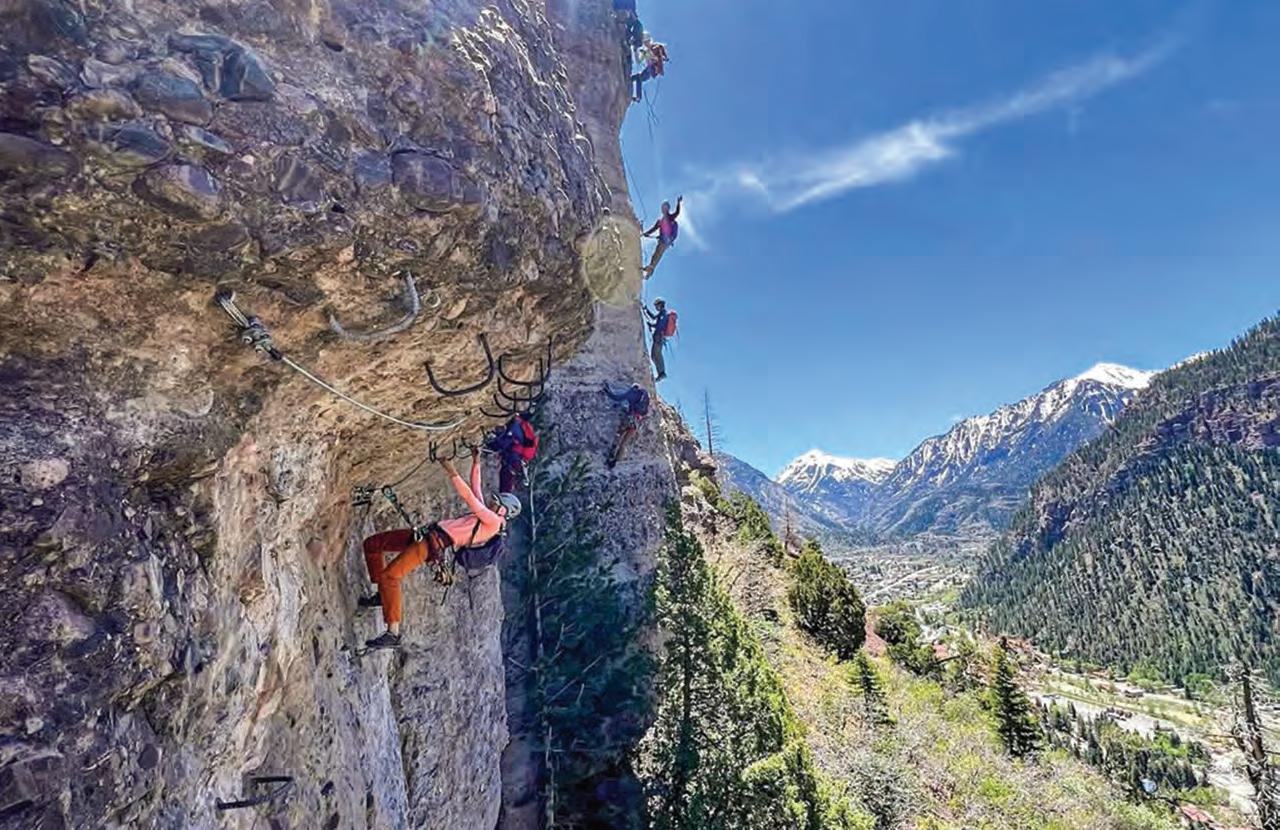
Colorado’s vertical frontier
Just before I’d stepped onto the first rung an hour earlier, Cook cautioned, “It’s best to just not fall.” He said it with the halfsmile of someone who’s spent a quarter-century guiding climbers across Colorado’s most formidable terrain in the San Juan Mountains.
Cook is co-owner and head guide of Basecamp Ouray – exactly who you want in your corner when your muscles give out midair. In addition to his 25-year guiding career and experience building via ferrata courses, he was the 25th American out of 200 to earn certification from the International Federation of Mountain Guides Associations, the most prestigious guiding organization in the world.
Stoic, self-assured and endlessly competent, Cook has spent his life and career in the mountains – although he grew up in what he jokingly calls the “mountainous state of Kansas.”
I met Cook and guide-in-training Erin
Laine one summer morning outside Basecamp’s headquarters – a hybrid climbing gym and community hub on Ouray’s bustling Main Street.
Laine, with a sun-bleached ponytail and easy confidence from winters ski guiding around the globe, handed me my gear: helmet, gloves and a Y-shaped leash attached to a harness. Two metal locking carabiners, called “lobster claws,” clip onto a cable bolted into the cliff. Though safety gear prevents a fatal fall, the leash’s shock absorber could still let a climber tumble six feet – hence Cook’s warning.
Via ferrata is Italian for “iron path,” a name that makes more sense when you’re clinging to rungs bolted into sheer rock with nothing but air below. Originating in the Alps during World War I, the concept helped soldiers navigate the mountains. Today, these routes offer recreational adventure across Europe, bridging hiking and full-on climbing.
In Colorado, access is still relative-
ly new – and limited. Of two dozen U.S. routes, 10 are in Colorado, including four in Ouray and Telluride. Most lie on private land or ski resorts and require a guide due to permitting and safety. Telluride’s was the first public, unguided route; Ouray manages two more public routes, which Cook helped build.
Gold Mountain is one of the newest and most ambitious entries in this vertical frontier. Climbers can go with a guide from Basecamp Ouray or opt to go self-guided for a $99 fee. At the trailhead five minutes from town, Cook briefed us: this was the most challenging via ferrata in North America. The route climbs 1,200 vertical feet across 12 “pitches” and ends in a tightrope walk across a 300-foot suspension bridge – the second longest in the nation.
The idea was born during COVID, when outdoor recreation skyrocketed. Logan Tyler, Basecamp’s founder and a former professional climber, saw an opportunity to build a world-class route that mimicked


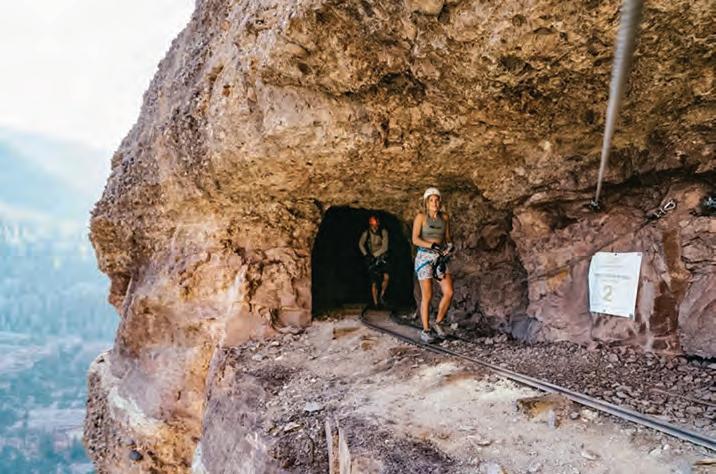
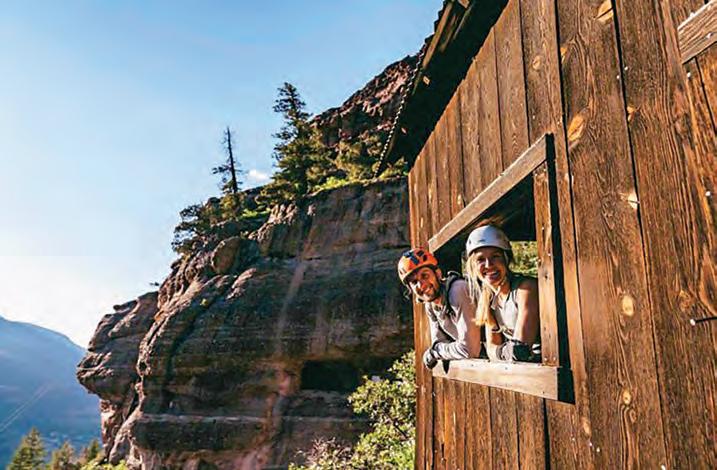
Europe’s vertical pedigree. While most via ferratas in Colorado traverse sideways, Gold Mountain climbs upward and incorporates natural rock features.
The private land was purchased for a good deal. Tyler persuaded the Texas landowners to consider a route up the towering cliff. Over four months, he and a small team hand-drilled more than 2,000 feet of cable, over 1,000 rungs and two suspension bridges. It opened in 2022.
One pitch at a time, the route carried us higher – across sky bridges, past mine shafts and into the layered history of Gold Mountain, its soil still glinting with gold.
The climb began with a stout vertical section. As a hobbyist rock climber, I felt confident on the wall, though a few moves pushed me outside my comfort zone – and I was grateful for my experience. No climbing background is required with a guide.
We scurried upward, our carabiners clicking on the cable between bits of Cook’s commentary and quiet encouragement.
Red walls cradled the old mining town as waterfalls laced the cliffs, snowmelt feeding the Uncompahgre River. Its name, from the Ute language, means “red water,” “dirty water” or “slow-moving water.” Though not red, the river often appears muddy yellow – likely due to hot spring minerals or old mine runoff.
At the top of pitch four, a short hike brought us to the next climbing section and a rickety ore-sorting house from the Memphis Mine, part of some 120 claims dating back to the late 1800s.
We followed some of the same paths and gold veins the miners once did. “There aren’t many places you can get this up close and personal with Colorado’s mining history,” Cook said.
After that walk through history, we hit the first decision point. The route offers three optional deviations for climbers who want a tougher challenge.
I opted for the extreme every time.
The Don Wall – a nod to Yosemite’s Dawn Wall and to a beloved local guide who died in an off-roading accident –gave me a taste of traditional climbing. Traversing sideways on a bulging rock face, I reached for granite pockets while
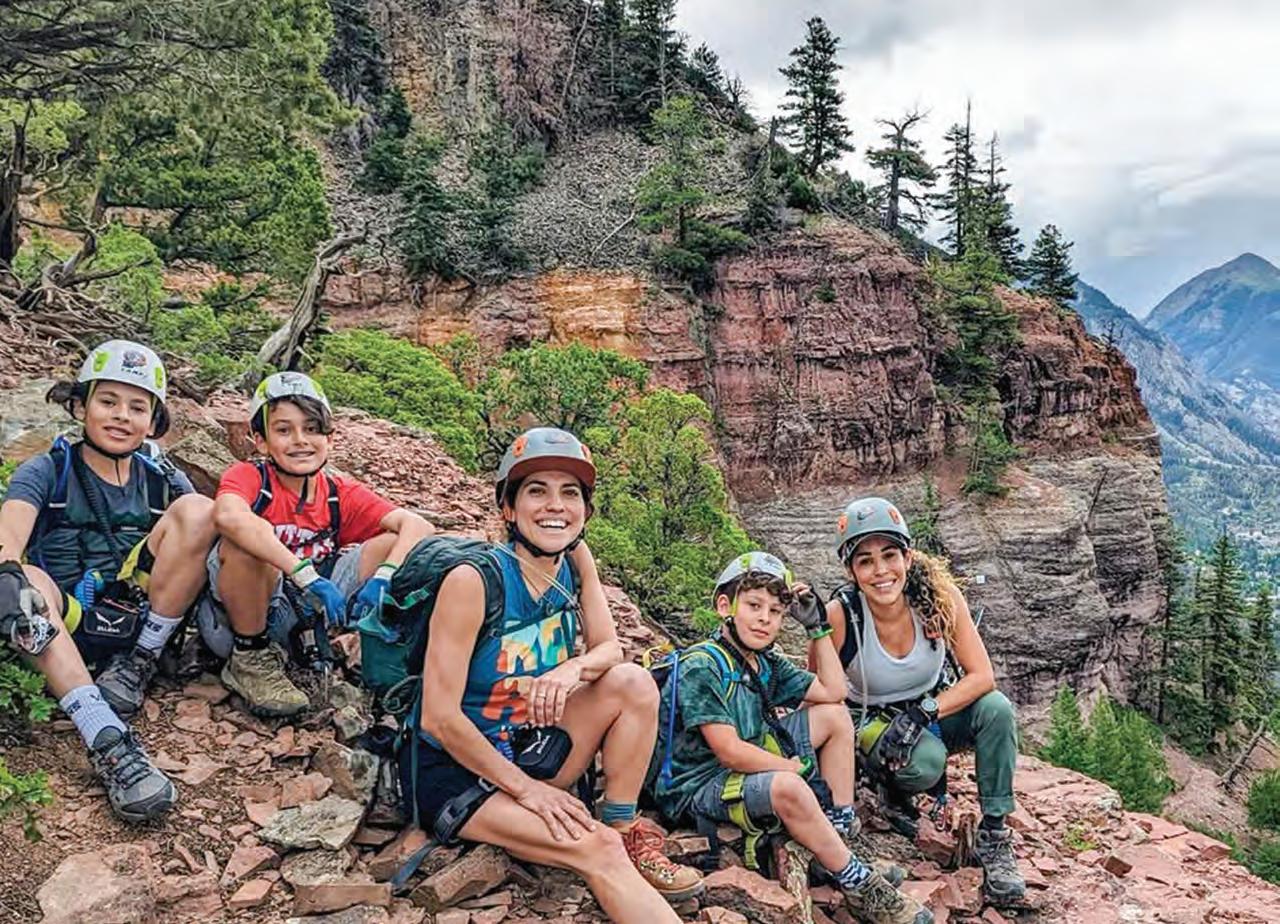
my toe smeared across pebbled ledges. Cook guided me through calmly: “Find those rungs. Keep moving sideways.”
After more scrambling, we followed a narrow ore cart railway through a tunnel blasted in the rock.
“Imagine going up this same cliff we’re climbing at 30 miles per hour,” Cook laughed. “That’s what these miners used to do.”
As the tunnel ended, so did the tracks. A steep drop gave way to the first cable bridge, which Cook, Laine and I walked duck-footed across, white-knuckling the handrails. It led to a weathered, century-old blacksmith shop. Inside lay rusted rods and a dusty miner’s boot.
The pièce de résistance came nearly 1,000 feet above the start. We had finally reached the notorious Monkey Bars – North America’s hardest pitch – requiring
strength, precision and nerves of steel.
After swinging through most of it with help from my guide, I exhaled – only to face an overhanging arête, estimated by climbers to be a 5.10+, a difficult climbing grade. On spent arms, I worked up the last few feet to find Cook waiting with an enthusiastic high-five.
Only one obstacle remained: a 273-foot suspension bridge, the second longest of its kind in the country. As I stepped across, one foot in front of the other, the wind swayed the structure and my stomach turned until I reached solid ground.
I looked back and traced the jagged line I’d climbed. It was dizzying to see how far I’d come – 1,200 feet below. Somewhere between the iron rungs and Gold Mountain’s relics, fear had transformed into focus, and awe into understanding.
The hidden gem of Ouray is often referred to as the “Switzerland of America,” and from this height, the name rings true. Nestled in a box canyon and stitched with historic mining scars, this part of southern Colorado is carving a new alpine legacy – one that fuses its past with a bold, vertical present.
Once a tool of war, via ferrata has become something else entirely: a way to meet the mountains halfway.
As Colorado’s own via ferratas reach new dizzying heights, so do the people who climb them. By the time I unhooked my lobster claws and rang the celebratory gong at the summit, I felt something like the rush of a gold strike.
Not metal in the dirt – but something rarer: the grit you find from within.

More than 6 million visitors have ridden the historic Estes Park Aerial Tram since it opened 70 years ago. It was America’s first scenic tram. The lift climbs 1,060 feet in five minutes up Prospect Mountain.

by ERIC PETERSON
SOARING UP PROSPECT Mountain in Estes Park, an ageless relic from another era has taken on new life.
That relic is the Estes Park Aerial Tram, whisking bright red cars full of passengers upward 1,060 feet in five breathtaking minutes –just as it has nearly every summer for the past 70 years. At the summit, visitors can savor panoramic views of the Estes Valley and Continental Divide from a viewing platform and hike a short trail before descending back into town.
More than 6 million riders since its grand opening –and two years after nearly shutting down permanently –the family-friendly tramway remains a beloved Colorado landmark, melding fascinating history, mechanical ingenuity, endless vistas and genuine thrills.
Robert Heron, a pioneering innovator of ski lifts and tramways, built the Estes Park Aerial Tram in 1955. “It was America’s first scenic tram,” said Adrian Liddell, the tram’s general manager. “When it was built, there was nothing out there like it.”
During World War II, Heron designed a mobile tram for the U.S. Army’s 10th Mountain Division that helped Allied troops capture Riva Ridge in Italy in early 1945. Post-war, Heron quickly influenced Colorado’s ski industry by constructing Aspen’s first ski lift in 1946. Aptly named Lift 1, it was celebrated at the time as “the highest fastest and longest” chairlift on Earth and today is one of only two ski lifts on the National Register of Historic Places.
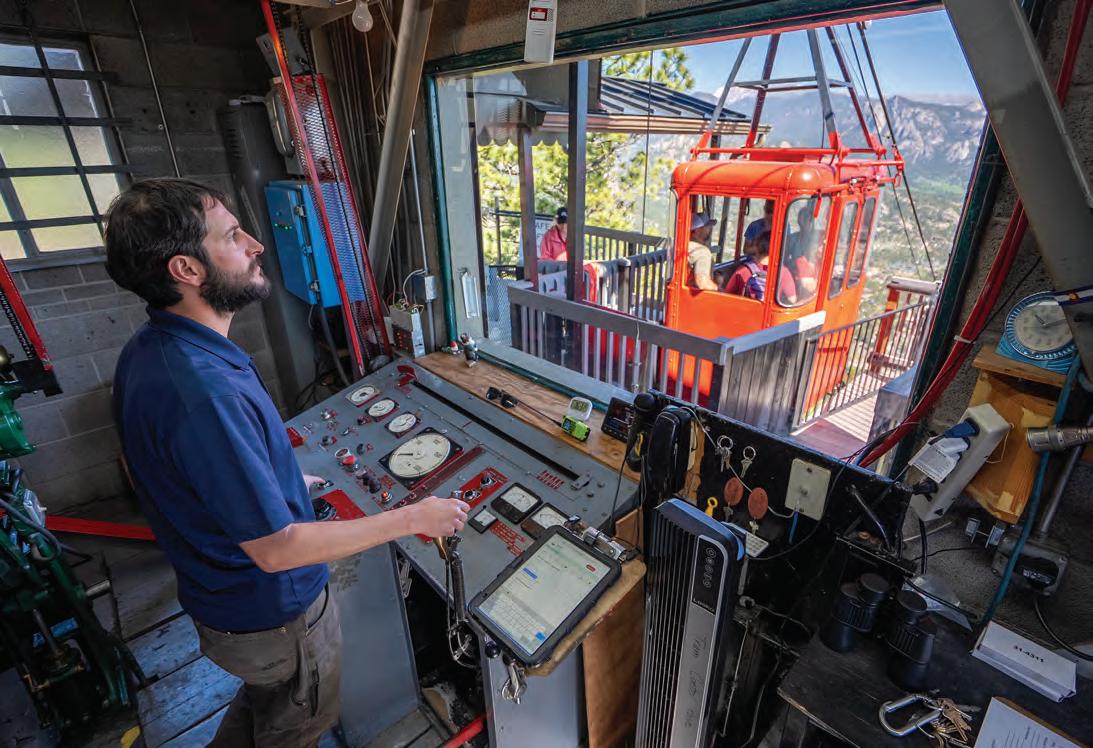
HERON’S DENVER-BASED firm, Heron Engineering, subsequently introduced the first fixed-grip lifts at many ski resorts, including Colorado’s first double-chair at Berthoud Pass and the nation’s first triple and quad lifts at Boyne Mountain in Michigan. Over his career, Heron contributed to building more than 100 ski lifts and tramways.
In the early 1950s, Heron envisioned his own scenic tramway in Estes Park as both a tourist attraction and showcase for his engineering expertise, drawing inspiration from European designs.
Unlike traditional ski lifts, the Estes Park tram’s cables span directly between upper and lower terminals without towers in between. “It’s like flying, but you’re still attached to the ground on both sides,” Liddell said. “It’s a 2,630-foot free span, so there are no bumps. My predecessor described it as an inline helicopter.”
While such free-span trams are relatively rare in the U.S., they are common in Europe’s steep alpine terrain. The Estes
tram system uses separate cables for cabin support and propulsion.
After Robert Heron’s passing in 1999, his son, John Heron, managed the tram until his own death in 2022. The family then put the historic attraction up for sale.
Initially, prospects seemed bleak. Locals worried about losing a beloved attraction, but fate intervened: After a summer-long closure, the tram reopened in 2024 under the ownership of Gondola Ventures, a company specializing in tramway projects.
The reopening meant much to Estes Park residents, especially Liddell, who first joined the tram crew as a 16-year-old car attendant in 2007. The summer gig turned into full-time work, and he was promoted to general manager in 2019. “I really fell in love with the machine and the mechanics of it,” he said. “I’ve always had a passion for old stuff, old machines, old cars. I’ve always liked tinkering.”
This passion makes Liddell ideal for the role. “The physical lift itself is relatively unchanged since it was built,” he
explained. “I’ve got 25 buttons dials and gauges on the control panel. It was steampunk before steampunk was cool.”
The simplicity of Heron’s design eases maintenance, often allowing repairs with standard, off-the-shelf parts. “Lifts these days have gotten very complex and are difficult to work on,” said Liddell. Not so for the Estes Park Aerial Tram: “It’s not run by a computer. It’s driven by an individual in the motor room at the top of the mountain.”
Liddell and his crew troubleshoot issues with traditional mechanical skill. The tram occasionally has a stubborn personality, halting operations if problems arise. “It’s got a personality,” he noted. “You’ve got to work with it, bargain with it sometimes.”
Perry Shea, Gondola Ventures’ managing partner, praised Liddell’s maintenance expertise. “He’s a phenomenal general manager and takes pride in that work,” Shea said. “It shows because the tram is in very good condition.”

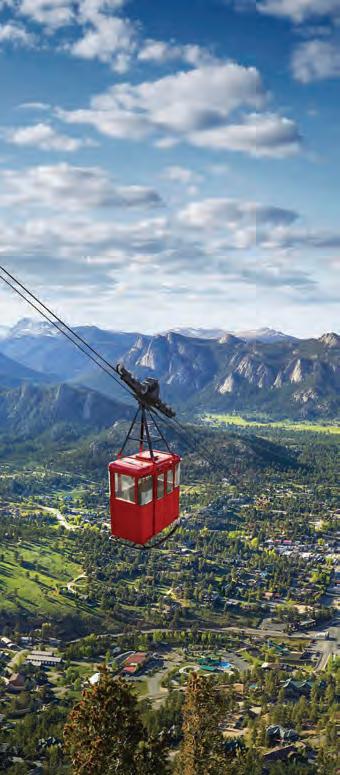
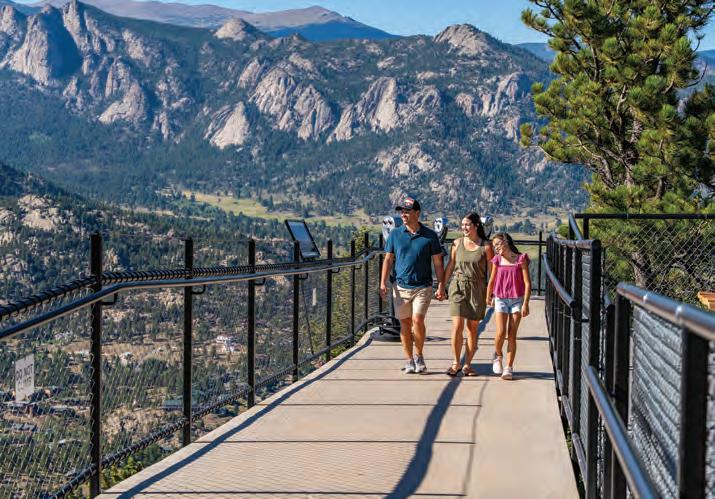
After two years of closure, the iconic tramway beckons to families once again. From town, the tram takes 10 passengers up at a time to the summit’s viewing platform, where a short hiking trail and sweeping vistas of Estes Valley and the Continental Divide await.
THE TRAM’S WELL-MAINTAINED condition was a major selling point for Gondola Ventures when it acquired controlling interest in 2023 – but not the only one. “We focus on iconic systems,” said Shea. “We want people to experience the outdoors recreationally and reach mountaintops otherwise inaccessible.”
The Estes Park Aerial Tram matches this vision perfectly. “When you take the tram up, that 360-degree panoramic view on Prospect Mountain is unmatched,” Shea said. “We could build cable cars in many places, but this tram provides an experience and a story worth telling.”
Gondola Ventures plans to enhance that experience soon. Improvements include revamping the mountaintop Hungry Chipmunk Cafe and gift shop, adding an events space and viewing deck at the upper terminal, and upgrading the tram cars to accommodate more passengers. But the tram’s retro charm won’t vanish. “The red cabin will look the same, just a little longer and wider,” Shea said.
The company is also involved in tram projects in Australia and Hawaiʻi, recognizing potential in both urban transport and tourism. In Colorado, Gondola Ven-
tures is balancing Estes Park improvements with constructing the Mighty Argo tram at Idaho Springs’ historic Argo Mill and Tunnel, expected to open next year. “The Argo Mill is a fun attraction, and when the cable car opens next to it, it will draw even more visitors,” Shea noted.
If the Argo tram matches Estes Park’s appeal, success seems assured. Estes Park’s tram brings out youthful delight in passengers of all ages. Liddell recalled a passenger playfully waving his toupee at an ascending car’s attendant. “He joked the whole way down,” laughed Liddell. “He said, ‘Should I wave my hair at her?’ Then he took off the best toupee I’ve ever seen and waved it like a flag!”
For Shea, creating joyful experiences is key. “When I see old black-and-white photos from the tram’s early days, smiling faces in cabins heading to Prospect Mountain, kids on their dad’s shoulders looking at the mountain views, that’s something I cherish,” he reflected. “That’s why we do this – it’s about those experiences.”
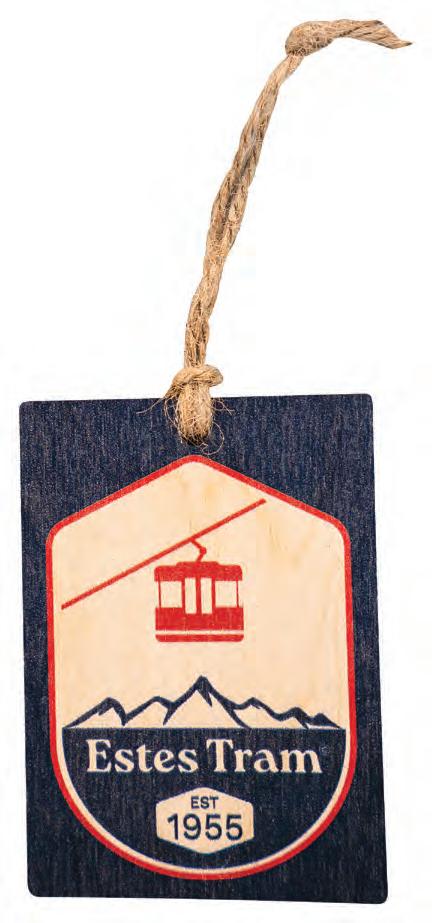

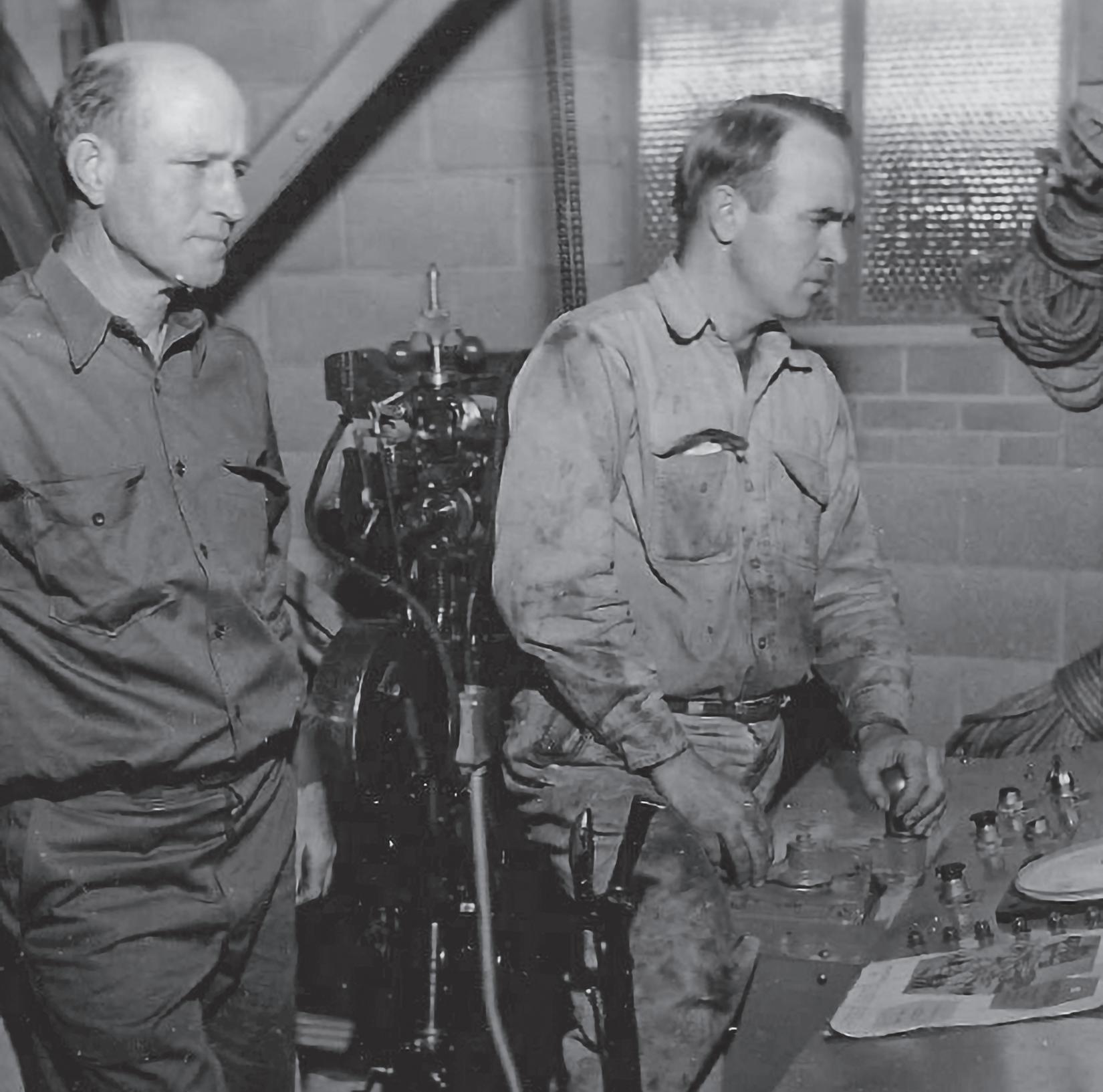

Since 1955, the Estes Park Aerial Tram has carried passengers to the summit of Prospect Mountain – and into the pages of Colorado history. Here are a few fast facts that might surprise you:
• Original steel – The guide cables installed in 1955 are still in use today – greased, inspected and going strong.
• Built by a legend – Robert Heron, a ski-lift pioneer, designed and built the tram as a personal showcase for his engineering firm.
• Twin power – The red cabins counterbalance each other: one goes up as the other comes down.
• Heavy support – The west cable is weighted by 48,000 pounds of concrete; the east, 52,000 pounds.
• Manual muscle – No computers here. Operators use analog controls and a 54-hp electric motor to run the tram.
• Failsafe braking – If the operator becomes unresponsive, a magnetic safety brake automatically engages.
• Power play – The tram converts AC to DC power and can feed energy back into the grid via regenerative braking.
• Weight check – Each cabin holds 10 passengers, assuming an average of 200 pounds each.
• Backup drive – A gas-powered Ford tractor engine is on standby in case of power loss.
The Estes Park Aerial Tram (www.estestram.com) is located at 420 E. Riverside Dr. in Estes Park. Its 2025 season runs May 25 through Nov. 2.







by ARIELLA NARDIZZI
JULY 4-5 • PAONIA
Sweet traditions and small-town charm ripen in Paonia each July during the 79th annual Cherry Days festival. The town celebrates its heritage – and famous cherry harvest season – with two days of fun, flavor and spirit.
July 3 is all about the community. For Downtown Day, Grand Avenue bursts with sidewalk sales from local businesses. Visitors drift from boutique shops to art galleries, and various restaurants and bars offer craft cocktails and a bite to eat.
Over in Town Park, the heart of the festival beats with arts and crafts booths, local food vendors, live music and quirky competitions like the cherry pit spit and wood splitting. A baking contest challenges contestants to craft a sweet treat of any kind, just as long as it includes cherries. For kids of all ages, the Adventure Zone
transforms the football field into a playground of epic proportions.
Fuel up bright and early on July 4 with the North Fork Rotary’s Pancake Breakfast at Town Hall, where hungry festivalgoers fill their stomachs before the highly anticipated Cherry Days Parade. By mid-morning, Grand Avenue fills again with whimsical floats, classic cars, horse teams, Cherry Days royalty and the ever-zany Clown Band, whose original costumes were first stitched together from World War II parachutes.
A simple fundraiser to secure lights for the football field that began in 1947 has since blossomed into one of Colorado’s longest-running community festivals here in Paonia. Cherry Days proves that the sweetest traditions are the ones that stick. paoniacherrydays.com.

This casual eatery utilizes local, ethically sourced ingredients to unite the community through food. Gather friends around the table for gochujang chicken and waffles, delicious shrimp and grits, or toast with a cold pint from Western Slope brewers. 208 3rd St. (970) 527-1041.

This expansive property offers a variety of lodging from camping to glamping. Choose from a cozy stay in a renovated wagon, school bus, tent site, tipi, cottage or mountain chalet. 40881 Hwy 133. (970) 808-7243.

Get a taste of the Western Slope by picking fresh fruit straight off the bush, tree or vine. June is cherry season, while July and August offer an abundance of peaches, nectarines, blackberries, raspberries, tomatoes and more. 15836 Black Bridge Road. (970) 527-6838.
The 79th annual Paonia Cherry Days celebrates sweet traditions with local vendors, a cherry pit spit, baking contest, live music, pancake breakfast and street parade.

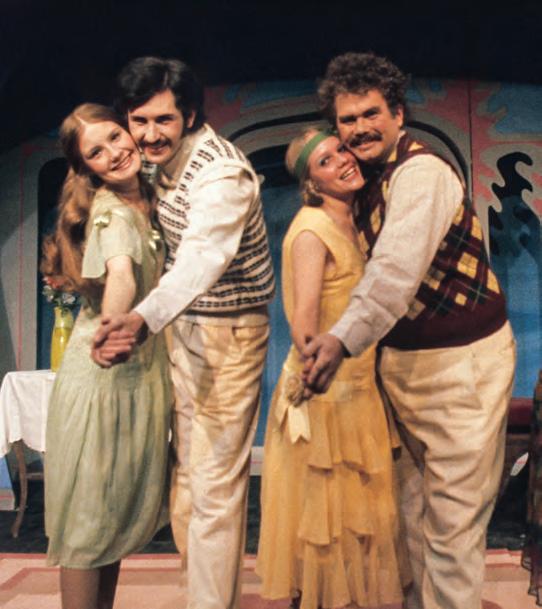

Creede Repertory Theatre celebrates 60 years of business in true repertory fashion: producing multiple shows simultaneously with a resident company of artists. CRT grew out of a need for local entertainment in the 1960s after the town’s silver boom ended.
JULY 18 • CREEDE
In the shadow of the mighty San Juans, where silver once flowed and mining camps bustled, something unexpected has taken root – live theatre. This summer, Creede Repertory Theatre (CRT) celebrates 60 seasons of grit, hope and divine inspiration.
When Creede’s mines shuttered in the 1960s, the town searched for a new identity. Jim Livingston, a local pastor, joined forces with the Junior Chamber of Commerce to revive local businesses and entertainment in town with summer theatre. They sent out letters to universities looking for actors. Just one reply came back – from Steve Grossman, a 19-year-old student at the University of Kansas. He gathered 11 fellow students and together, they drove west to spark CRT’s inaugural season.
With only $32 in the bank, the passionate group performed five plays. They built
sets by day and acted by night. Tickets were $1, and most of the audience had never seen live theatre before. From the first show of “Mr. Roberts” to “Our Town” and “The Rainmaker,” the stage lit up –and so did the town.
Now, they are nationally recognized for a true repertory model, producing multiple shows with resident artists such as “Xanadu” and “Boomtown! Improv.” The Mainstage Theatre, once a movie house, has survived floods, fires, renovations –and maybe even a ghost or two.
On July 18 at 7 p.m., CRT invites guests back to where it all began. The 60th Anniversary Concert is a heartfelt celebration featuring favorite artists and highlights from six decades of magic. From mining boom to theatre town, a good story – and a determined cast – can change everything. creederep.org. (719) 658-2540.

BIG DOUG’S BBQ
Come with a big appetite – and before they sell out for the day. This beloved barbecue joint is open seasonally for summer. Order mouthwatering brisket, wet and dry ribs, pulled pork or meat by the pound. 600 S. Main St. (713) 899-7067.

This historic boutique hotel is a former, red-brick fire house dating back to 1892. Each room reflects one of Colorado’s colorful seasons and offers a welcoming retreat along the Silver Thread Highway. 123 N. Main St. (719) 239-3401.

CREEDE UNDERGROUND MINING MUSEUM
Three local miners blasted solid rock cliff in 1990 to create this underground museum. Take a guided tour from a retired miner and learn about stopeing, blasting, blacksmithing, mucking and assaying. 9 USFS Road #503. (719) 658-0811.
South Fork Rodeo
July 2, 13 and 19 • South Fork
Riders rock the Rio Grande at Rickels Arena on July 2, 13 and 19. The show kicks off at 6:30 p.m., treating spectators to bull riding, barrel racing, sheep racing, roping, mutton busting and a calf scramble. Tickets are $15 in advance and $20 at the gate. 194 Warton Dr. (719) 873-5512.
Range Call Festival
July 3-6 • Meeker
Colorado’s oldest annual rodeo started in Meeker on July 4, 1885 – and the jubilee has only continued to grow since. In addition to 104 years of rodeos, parades, fireworks, concerts and barn dances, locals also reenact the famous failed Meeker Bank Robbery attempt from 1896. 700 Sulphur Creek Road. (320) 223-4351.
Fourth of July Celebration
July 3-6 • Steamboat Springs
Since 1927, the Yampa Valley has rallied around their annual Cowboys’ Roundup Days to celebrate Independence Day in true Western fashion. The multi-day extravaganza includes a hometown parade, rodeos, pancake breakfast and roller ski. Steamboat doesn’t host fireworks to promote wildfire prevention. (970) 879-0880.
Bobstock Music Festival
July 11-12 • Fort Morgan
Music lovers sprawl across the lawn at Glenn Miller Park to enjoy jams from 20 bands on five different stages at the region’s biggest free music festival. Fan-favorites like Uncle Kracker, Molly Hatchet and April Wine headline the show this year. Also available are vendor booths, a beer garden and food trucks. 414 Main St. (970) 867-5674.


FoCo Fondo
July 18-20 • Fort Collins
This quirky gravel course combines the classic idea of a long-race Fondo with a lighthearted, fun ride. There are five route options ranging from 12 to 118 miles around Fort Collins. All rides depart from New Belgium Brewing on July 20, while racers embarking on the 12-mile route leave on July 19.
8500 Peña Blvd.
Wray Daze
July 25-27 • Wray
Get crazy on Main Street for Wray’s three-day block party for Northeastern Colorado. Kick off the weekend with Family Fun Night on Friday at 6 p.m. Fun for all ages include a slippery match of mud volleyball, and the annual parade with floats supporting the theme, “Blue Jeans and Country Dreams” on Saturday at 10 a.m. Main Street. (970) 332-3484.








Crested Butte Arts Festival
Aug. 1-3 • Crested Butte
The 53rd annual festival fills the historic Elk Avenue with 150 juried fine art vendors and home-grown Gunnison Valley talent. Meander down Art Alley for crafting activities, visit the art auction tent and dance to live music at the Community Entertainment Stage. Elk Ave. (970) 349-1184.
Vino and Notes
Aug. 2 • Woodland Park
Teller County’s premier wine, food and jazz festival returns to Memorial Park for its 17th year. Colorado’s finest wineries present tastings alongside food vendors and local artists doing plein air painting. The music lineup includes sets from Tidal Breeze Jazz Arts, Shakin’ Like Sammy and Deryk Cunningham. 200 N. Park St. (719) 310-2335.
Kids Adventure Games
Aug. 7-10 • Vail
In its 15th year, the Kids Adventure Game – which began as a backyard obstacle course – has grown into an epic multidiscipline adventure race for kids ages 6-14. Teams of two will go by bike, on foot and through water to tackle a 2.5-4 mile course featuring 15 man-made and natural obstacles. Vail Mountain Plaza. (970) 401-3804.
Arkansas Valley Fair
Aug. 13-16 • Rocky Ford
“Be part of something great, attend the 148th” is this year’s slogan for Colorado’s oldest continuous fair. Attend “Silver Day” on Wednesday, “Kids Day” on Thursday, “Parade Day” on Friday or “Watermelon Day” on Saturday. Events include a carnival, rodeos, barrel and horse racing, a parade, demolition derby and car show. Activities take place around Rocky Ford. (719) 254-7723.
Affordable Arts Festival
Aug. 24 • Littleton
All fine art is $150 or less. Over 165 artists from around the country sell their work, including paintings, glass, clay, sculpture, metalwork, photography, mixed media, fiber and wood. Admission is $12 and helps fund student scholarships at Arapahoe Community College. 5900 S. Santa Fe Dr. (303) 330-8237.
Caveman Music Festival
Aug. 28-31 • Weston
Four days of music and adventure capture the small-town nirvana of Weston, tucked in the Purgatoire River Valley. Celebrate Americana music at Monument Lake Resort, with fishing, camping, hiking, glamping and boating. River floating is encouraged. Performers include Josh Weathers, Toadies, Jamestown Revival and Uncle Lucius. 4789 CO-12. (620) 640-3664.

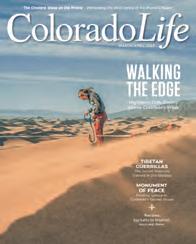
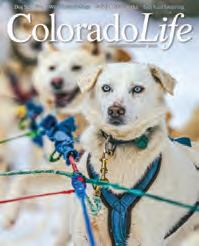

Questions on pages 16-17
1 Fish hatchery
2 Wildflower
3 White River National Forest
4 State Forest State Park
5 Balanced
6 a. New Mexico
7 a. Elk habitat preservation in winter
8 b. November
9 b. Loon Walking Trail
10 c. Red Shin Trail
11 False (it has slightly more than 8 miles of trails)
12 False (both parks are great birding locations)
13 True
14 False (some parks, like Roxborough, prohibit dogs)
15 True
Page 16 Rifle Falls in Rifle Falls State Park
Page 16 Ibis at John Martin Reservoir State Park
Page 17 Audobon Society of Denver’s HOOTennany at Chatfield State Park Trivia Photographs







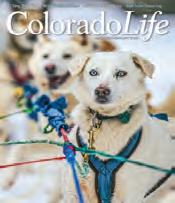
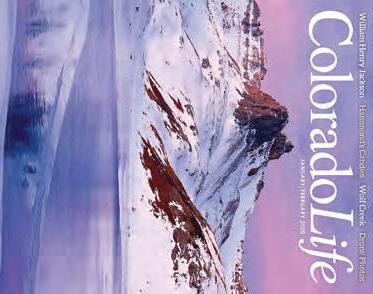
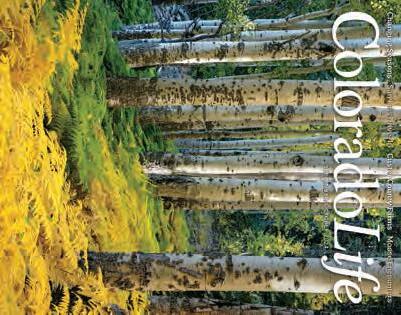
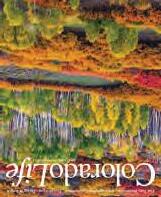
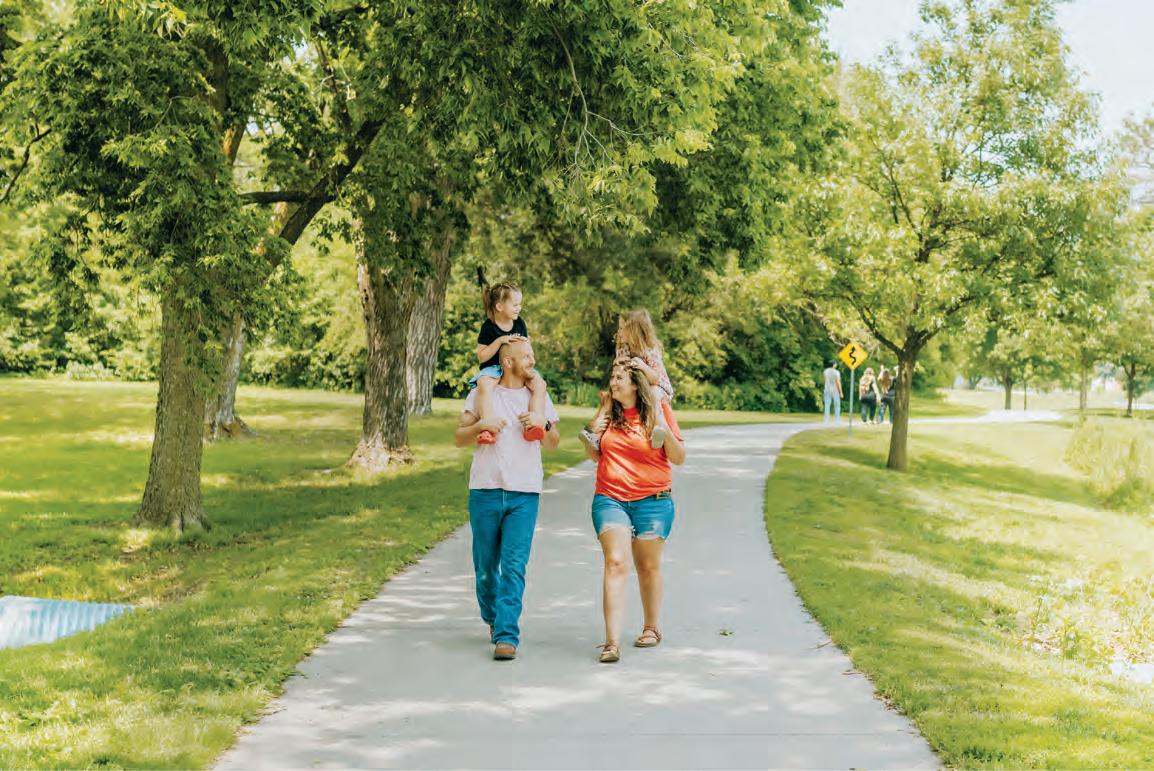





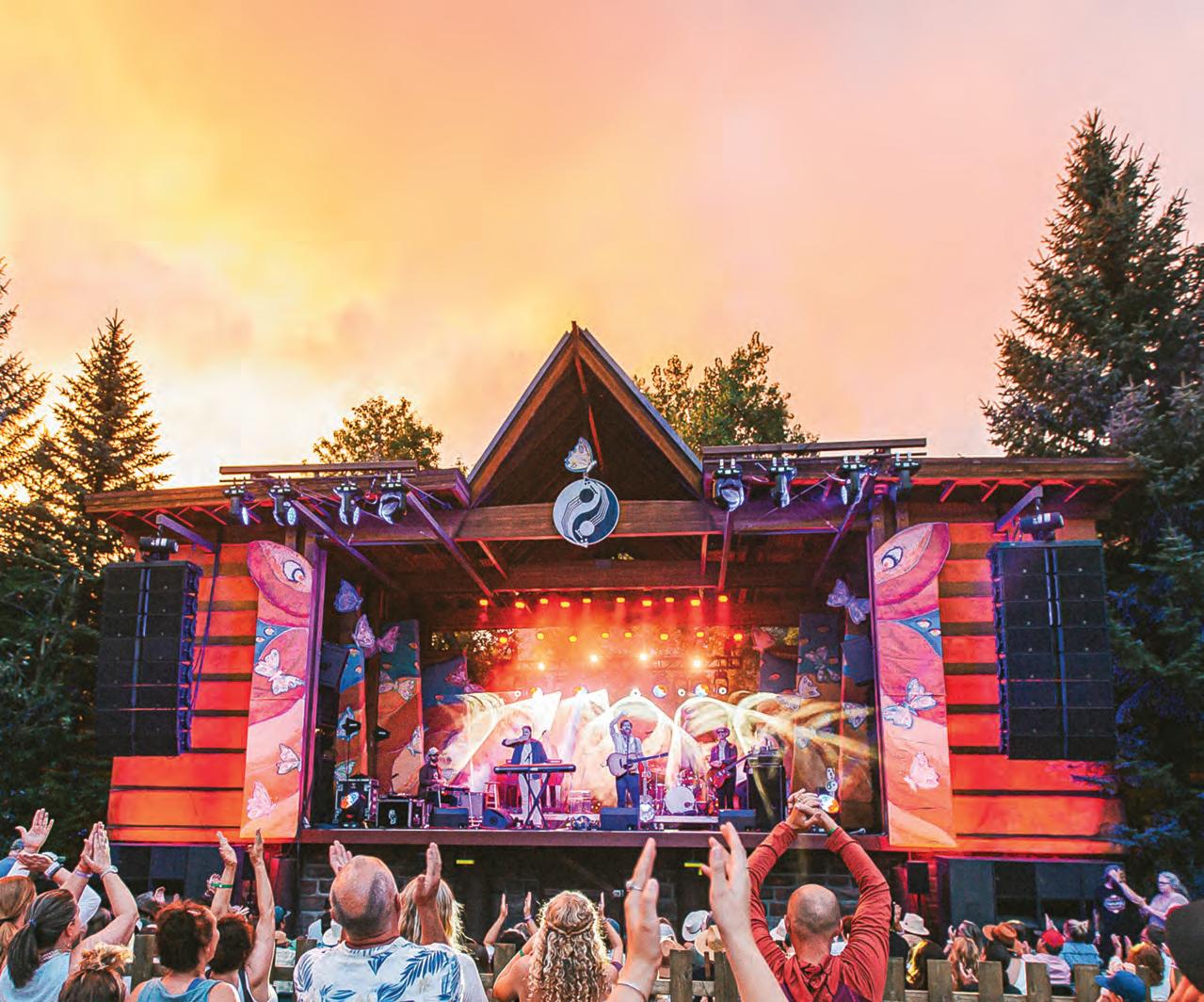
Every August, folk music wells up on the banks of the St. Vrain River in Lyons. Jackson Browne turned up there once – why not you?
by PETER MOORE
For more than 30 years, the Rocky Mountain Folks Fest has brought folkies together at Planet Bluegrass Ranch in Lyons every August for music, dancing and genuine connection.
KYRA HOLT, who runs the Songwriter School at the Rocky Mountain Folks Fest, first frolicked on the concert site as a 10-year-old. Her dad bought the farm intending to turn it into a wildflower paradise. Instead, a folks festival bloomed and has continued to do so every August (this year’s festival is Aug. 8-10).
You may wonder: Is that “s” in “Folks” a typo? Absolutely not. Holt explains, “It’s meant to address the universality of what we do here. Every tent is welcome in our campground.”
And a big, tuneful tent it is.
I’m a huge fan of folk music, with or without the extra “s,” so when I moved to Colorado, the Rocky Mountain Folks Fest
– with dozens of performers, an idyllic venue and a foothills location – was high on my to-groove list.
My wife and I were there last August to throw down a blanket, open our cooler and soak in the stream-side vibe and sunshine. About four thousand other folkies joined us. We hung out on the lawn in front of the mainstage, but many music fans kicked up dancing dust to the right of the stage or cooled their ankles in the St. Vrain River. Their happy, rambunctious kids were everywhere. A high red cliff loomed above the lazy river, bouncing banjo licks into the universe. It’s every bit as striking as Red Rocks in Morrison, but with less big-name preening and lots more hippies.


Just the way I like it.
If that evokes visions of festivarian muck and chaos, let me assure you: the Rocky Mountain Folks Fest is what Woodstock would have been if IBM had run it. The grounds are immaculate, the rainbow of music lovers joyful and well-behaved, and food vendors dish out delicacies on reusable plates with metal utensils. Sweet volunteers guide you to recycling basins, and your falafel plate serves the next folkie. Most surprising of all, the bathrooms stay orderly and odor-free, with short lines. Business schools ought to study this place. If the organizers can make Woodstock-bythe-St. Vrain work, they can do anything. Last year our big draw was the folk-har-
mony group Darlingside. Hearing the band bring my playlists to life felt like a blessing.
Still, after Darlingside left the stage to a roar, I felt a pang of regret: I’d hoped they would encore with their version of “The Parting Glass,” a traditional toast to friends long gone – the perfect capper.
I wandered off for a beer. Near the food court a golf cart beeped politely behind me, loaded with the entire band. I caught a player’s eye and blurted, “I hoped you’d finish with ‘Parting Glass!’ It would have been perfect!”
He paused. “You know, we’ve never done that as an encore. Maybe we should.”
As the cart rolled away I heard them discussing my suggestion. If you see Darling-
side encore with “Parting Glass,” you owe me a beer.
Craig Ferguson bought the farm from Kyra Holt’s dad and raised his family –and the Folks Fest – from the farmhouse in the middle of it all. The festival itself was born in a Chicago conference room, where Ferguson, then a lawyer avoiding “a real job,” launched an international troubadour festival featuring acts from Russia and Ireland. The event eventually migrated to Lyons and the singer-songwriter format that fills today’s stage.
He rattles off alumni with pride: Don McLean, Josh Ritter, Ani DiFranco and Brandi Carlile. And that guy named Jackson Browne, who said, “This is what I had in mind when I was about 15 or 16 and I thought it would be really great to travel around and play festivals. This was the festival I was thinking of.”
Another luminary is Mary Gauthier (goSHAY), who debuted as a performer and became a sought-after instructor in the festival’s songwriter school.
“I’d never taught before,” says Gauthier, whose song “Mercy Now” has been my anthem through the troublesome 2020s. “The songwriter school opened a door in my mind – not only that I could do it, but that I should do it.”
Every year a new generation of folkies arrives in Lyons, eager to connect with one another, the landscape and their musical futures. “I don’t want people to sing their diary,” Gauthier says. “Navel-gazing is boring. I want people to go deeper than the personal, to find the universal. That’s where we meet – where melody, metaphor and fiction converge to point to truth.”
Yes, she’s that kind of songwriter, and the Folks Fest is that kind of event.
Those truths land in Lyons every summer because of the people looking up at the stage. “It’s the ideal audience for someone like me,” she says. “People who read books, listen to NPR and have a discerning sensibility different from the dive bar. It’s not political. It’s that the Folks Fest crowd shares a love of language. The grass in front of the stage is full of them.”
She pauses, then adds, “It’s one of the better stages in the whole world.”
And it’s right here in Colorado. Maybe you’re one of the word-loving, pluralistic folks who belongs at this festival, too?

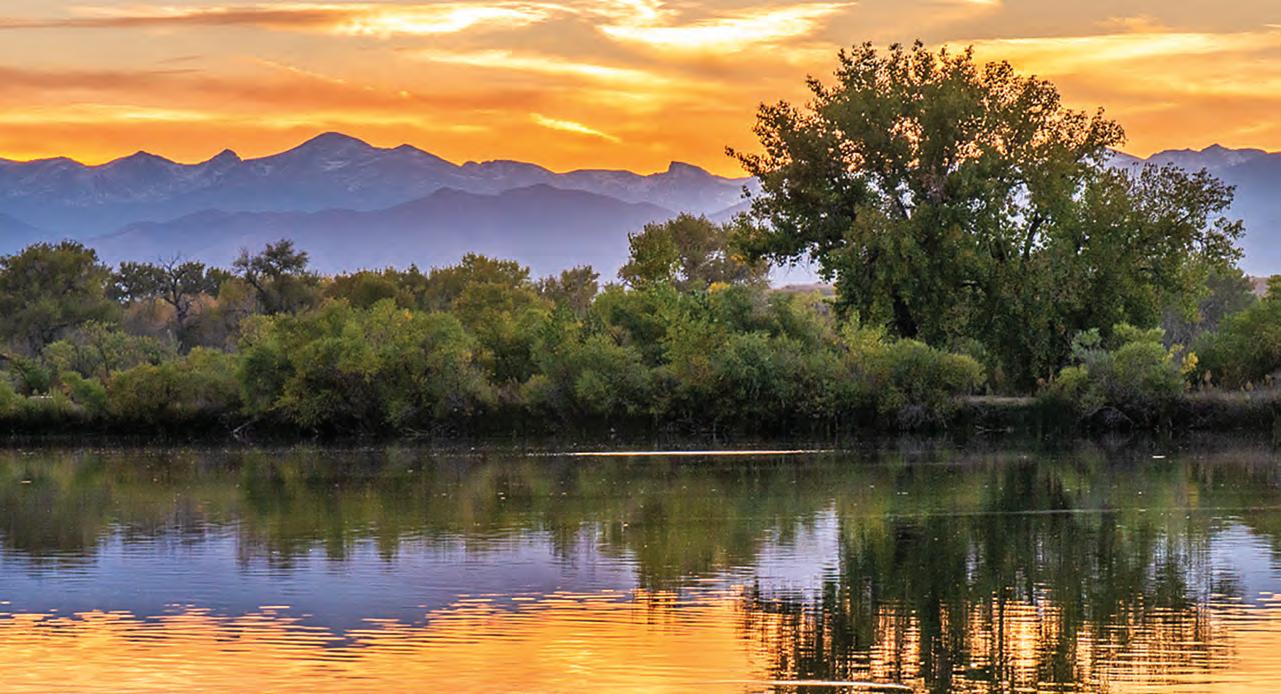


St. Vrain State Park offers quick, weekend escapes for Front Range, Denver
LOCATION
4 miles east of Longmont
TENT RV/SITES
Both
ACTIVITIES
Hiking, biking, fishing, non-motorized boating, kayaking, canoeing, paddleboarding, tubing, birdwatching, horse-back riding
CAMPING TRIPS FOR MANY of us fall into one of two broad categories. There are vacation-level journeys where we pack up the motorhome, trailer or tent and drive miles into the Rocky Mountain high country or Western Slope canyon lands for long, lingering stays. And then there are sanity-break campouts. These are trips to close-to-home campgrounds where we can spend the weekend ogling the wonders of nature rather than staring at the neighbor’s backyard fence.
One sanity-break destination my wife and I have enjoyed is St. Vrain State Park,
which sits in Firestone near the intersection of Colorado 119 and Interstate 25, due east of Longmont. It offers 80 reservable campsites in eight separate loops scattered around an array of small ponds. Over half the sites feature full hookups with the others offering electrical connections. There are both flush- and pit-toilet restrooms, coin-operated showers, a dump station and even a pair of charging stations for electric vehicles. For those of us needing to keep tabs on reality, nearby cell towers provide decent phone coverage.
St. Vrain State Park began when the Colorado Department of Transportation purchased the land from private owners in the late 1950s to use as a gravel quarry site for building U.S. Highway 87, forerunner to today’s Interstate 25. Four years later, CDOT gave the excavated gravel pits to Colorado Parks and Wildlife, who transformed them
into today’s state park with modern visitor services and an ever-expanding campground. Today, the park covers nearly 700 acres, a third of which is water in the now flooded, gravel pit ponds.
Stocked with bluegill, sunfish, bass, catfish, black crappie, walleye, pike and rainbow trout, St. Vrain’s 11 separate ponds offer anglers a good reason to camp at here. With many campsites bordering the water, it takes only a short walk to find a spot to cast a line and hook the evening’s dinner. Those ponds, all named for various avian species, also provide a water-rich habitat for birds with over 200 species spotted here. Folks can often observe pelicans and blue herons, along with songbirds, waterfowl and raptors including great horned owls, osprey, American kestrels and bald eagles. Instead of the blare of an alarm clock, we often awaken to flocks of redwing blackbirds chirping a melodic, early morning wakeup call.
St. Vrain’s ponds also attract ground-treading wildlife such as coyotes and deer with fox and bobcats occasionally found prowling near camp. A campground host told us that once they even had a moose drop by for a visit. While snakes aren’t something most of us want to see, the host told us that the park is home to a large population of non-venomous bull snakes, which he insisted was a good thing. It seems that bull snakes and rattlesnakes don’t get along, and with so many bull snakes slithering around the area, there are few rattlers to be found. Fortunately, I’ve never encountered either species on any of our visits.
For those of us who neither fish nor birdwatch, the park offers a pleasant enclave to simply hang out and appreciate the great state in which we live. Trails bordering the ponds provide pathways for pleasant strolls with Longs Peak and the Rocky Mountain Front Range offering a stunning backdrop to the west. At sunset, crimson skies can

make the ponds’ still, mirror-like surface blush redder than a 5-year-old getting into mom’s makeup.
Come nightfall, I’ll start a campfire while my wife fetches the ingredients to make s’mores, a favorite treat from her Girl Scout days. We roast marshmallows beside the flames, and when they reach a toasty brown color, we sandwich them with a Hershey chocolate bar between a pair of graham crackers. Tragically, we never had anything this tasty back in my Boy Scout days.
As the fire eventually dies down to glowing red coals, we’ll sit back, look up at the night sky and listen to the traffic. The biggest negative to camping at St. Vrain is that the park sits adjacent to Interstate 25. While the highway noise is a detriment, the freeway-side location makes access quick and easy. On getaway day, we can linger in our campsite until the noontime check-out and still get home in time to catch a Rockies game.
St. Vrain State Park is located four miles east of Longmont. Camping reservations can be made up to six months in advance through Colorado Parks and Wildlife (800-244-5613, cpwshop.com). Full-hookup sites cost $41 per night; electric-only sites are $36. Campsites farthest from the freeway are the quietest. A daily park pass ($10-12), an annual park pass or Keep Colorado Wild pass is also required.
Nearly 700 acres of St. Vrain State Park in Firestone offer unmatched outdoor recreation for anglers, birdwatchers, hikers and campers. Pelican Pond (left) is one of 11 in the park, which are surrounded by 80 reservable campsites like Mallard Campground (below).

COLORADO IS NICKNAMED “the mother of rivers,” serving as the headwaters for much of the United States. Rivers like the Arkansas, Rio Grande, Platte and Colorado begin as pristine snow but melt in summer and scream downstream from the Continental Divide. This runoff feeds cataracts with rapids that cut canyons from solid rock, creating dynamic, photogenic landscapes in every direction.
More than 2,000 waterfalls with at least 80 named drops exist in the state. Some are temporary trickles while others flow yearround. Waterfall fans – and photographers – could spend a whole summer chasing plunges across Colorado, but here’s a checklist focused on Western Slope waterfalls that can be visited in a weeklong road trip. Pack your wide-angle lens, neutral density filters and a towel – you’ll need them.
Starting at the Great Sand Dunes, where we featured Medano Creek in the last issue, a Bureau of Land Management area about five miles along State Highway 150 outside the park houses the hidden wonder of Zapata Falls. Nestled in a narrow canyon, the 30-foot cascade isn’t the tallest, but its gently descending waters offer an intimate closeup for photographers willing to get their feet wet. Long exposures soften the flow; handheld shots capture spray and sparkle. Bring a waterproof bag – and extra socks.
Heading west from the Sangre de Cristo Mountains into the San Juans between Creede and Lake City brings you to North Clear Creek Falls. A marked exit on the southeast side of the Silver Thread Byway (State Highway 149) leads to a large parking area and overlook.
A study in contrast, the serene, brushlined creek suddenly plunges more than 100 feet and hammers the rocks below. Rainbows appear reliably in the mist: a classic setup for lens lovers looking to frame color against craggy cliffs.
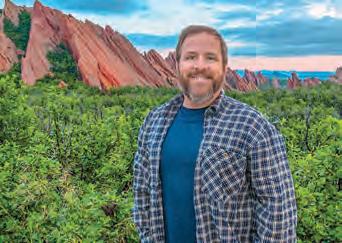
From Lake City, you can choose the Alpine Loop through rugged terrain – if your vehicle is up to it – or stick to paved roads leading to historic mining towns. Telluride is a standout. From bustling Colorado Avenue, Bridal Veil Falls spills like a ribbon from a 365-foot cliff. A 1907 hydroelectric powerhouse beside the falls adds a historic subject for wide-angle shots, especially at sunset when light glows on canyon walls. Drones are sometimes used here, though regulations apply – check before flying.
Nearby Ouray offers two waterfalls within walking distance. The 270-foot Cascade Falls is visible from most of town and approached where 8th Avenue ends. Less apparent is the 285-foot Box Canyon Falls, tucked inside a quartzite gorge in a park filled with hiking trails.
Continuing north toward Grand Junction brings a rare chance to photograph waterfalls among the red-rock canyons of the Colorado Plateau. Big Dominguez Canyon waterfall lies about a half-mile into a wilderness hike. This Gunnison River tributary falls beside ancient rock art, with boulders and desert bighorn sheep offering bonus composition elements. Wide vistas, layered geology and wildlife encounters make this spot a visual outlier in Colorado’s waterfall catalog.
Turning east on I-70, canyonlands give way to lush, jungle-like settings. Rifle Falls State Park features three bright torrents plunging from an 80-foot travertine hill.
These are among the most accessible –and photogenic – in the state, requiring less than a quarter-mile stroll to frame your shot. Thanks to clearings and even lighting, it’s a great spot for experimenting with composition or photographing waterfalls with kids in tow.
In the photo accompanying this column, I stood so close to the water I had to constantly wipe droplets from my lens. I used a shutter speed of 1/15 second to capture a mix of motion blur and sharp droplets – about the slowest speed you can handhold a camera. A tripod would yield more blur, but the heavy spray here makes standing still a very wet experience. Sometimes spontaneity beats setup.
About an hour farther east near Glenwood Springs lies perhaps the state’s most celebrated cascade. Hanging Lake looks like a Garden of Eden suspended from Glenwood Canyon’s walls. Reachable by a steep 1.2mile hike, the turquoise lake is carved from travertine by multiple waterfalls. Two hundred feet above, Spouting Rock gushes from the cliff face – a thrilling spot to photograph from below, if you can keep your gear dry. A $12 permit is required, with proceeds supporting protection of this fragile National Natural Landmark. In summer, arrive early to beat the light – and the crowds.
While falls elsewhere offer similar thrills, the Western Slope’s cascades provide the perfect excuse to pack your camera bag and explore Colorado’s wet and wild side. Here’s wishing you a satisfying sprint of waterfall wanderlust – and a memory card full of keepers.
Josh shot this photo at Rifle Falls
State Park with a Nikon D100 and Sigma 17-35 mm lens at 17 mm, exposed at f/20, 1/15 second, ISO 200.



